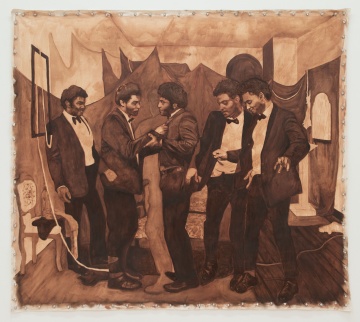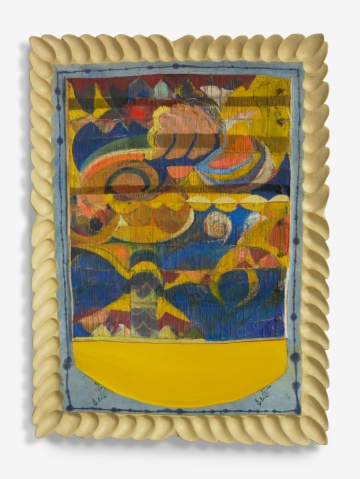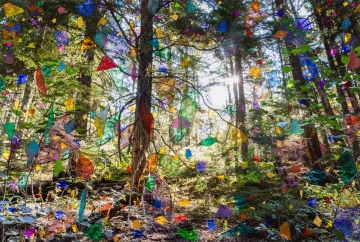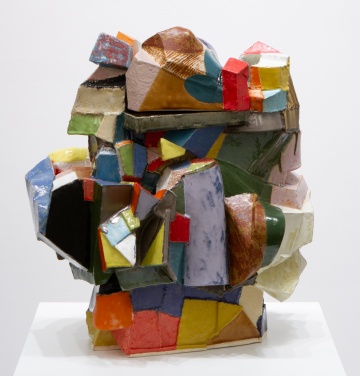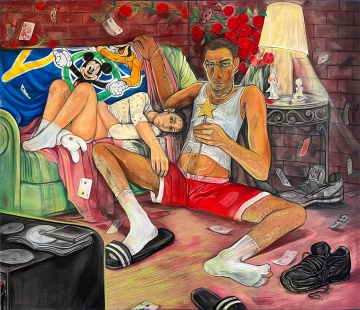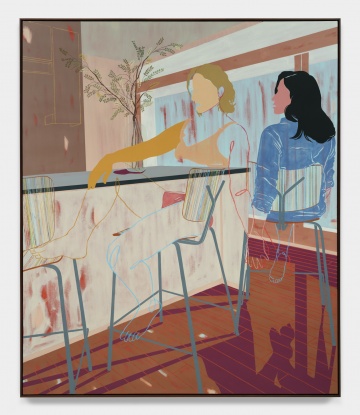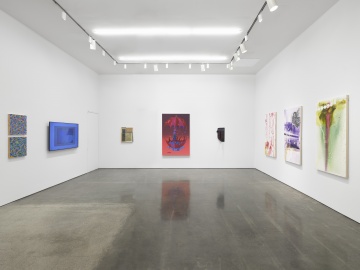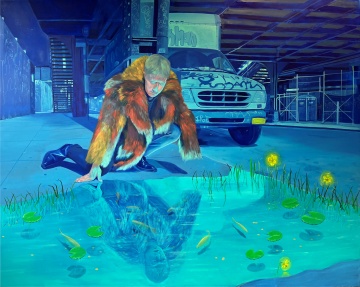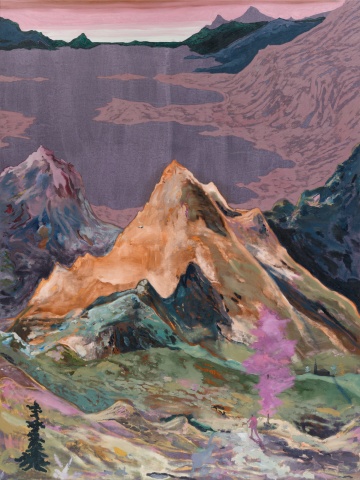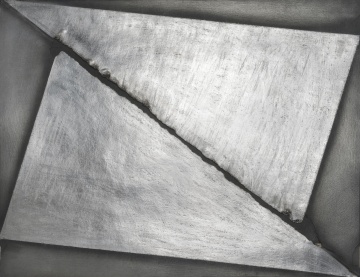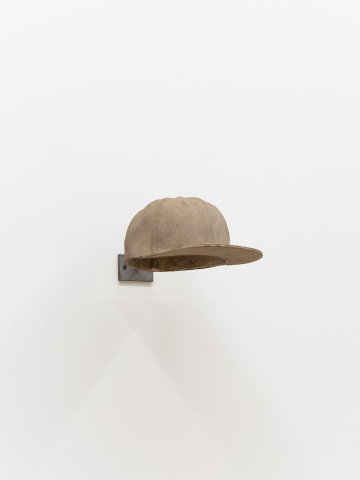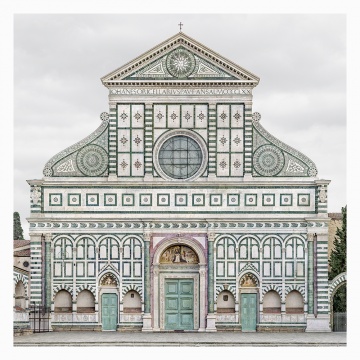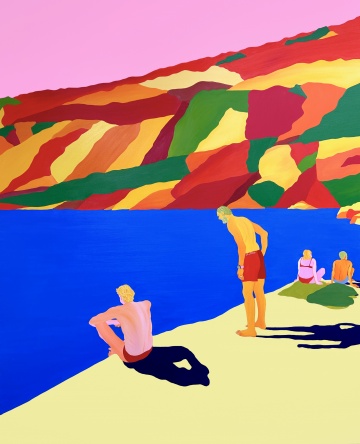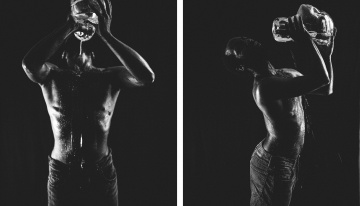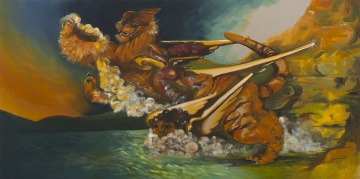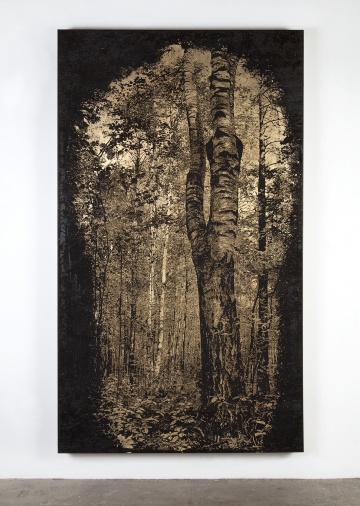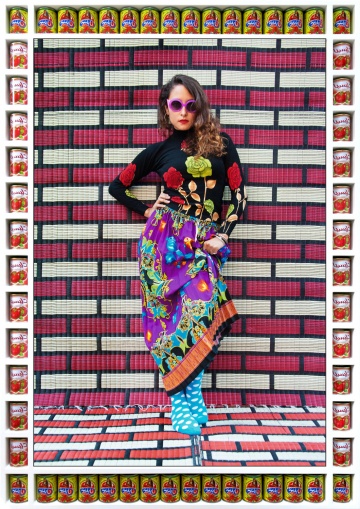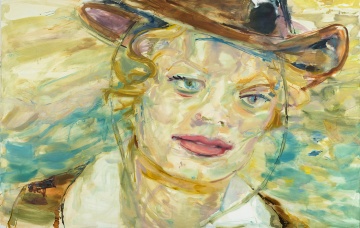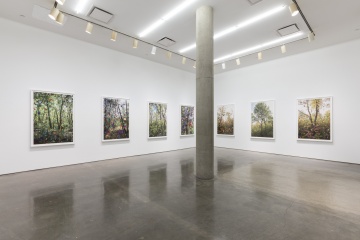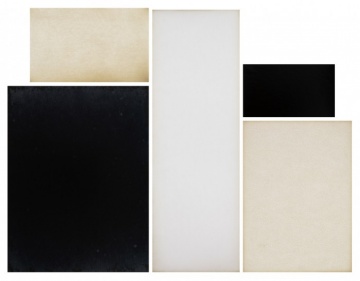Yossi Milo Gallery
245 Tenth Avenue
New York, NY 10001
212 414 0370
New York, NY 10001
212 414 0370
Established in 2000, Yossi Milo Gallery is dedicated to providing a platform for an influential community of artists working in all media, including photography, painting, sculpture, video and drawing.
Artists Represented:
Marco Breuer
Linus Borgo
Nathalie Boutté
Matthew BrandtMarco Breuer
Markus Brunetti
John Chiara
Angela Dufresne
John Gill
David Goldes
David Goldes
Hassan Hajjaj
Asif Hoque
Pieter Hugo
Pieter Hugo
Jeremy Jaspers
Simen Johan
Simen Johan
Sarah Anne Johnson
Pierre Knop
Myoung Ho Lee
Natia Lemay
Sze Tsung Nicolas Leong
Loretta Lux
Chris McCaw
Sze Tsung Nicolas Leong
Loretta Lux
Chris McCaw
Grace Metzler
Meghann Riepenhoff
Alison Rossiter
Mark Ruwedel
Alison Rossiter
Mark Ruwedel
Ibrahim Said
Paolo Serra
Shikeith
Shikeith
Sanle Sory
Ezra Stoller
Ezra Stoller
Raya Terran
Cameron Welch
Nevet Yitzhak
Kohei Yoshiyuki
Kohei Yoshiyuki
Works Available By:
Mike Brodie
Andrew BushBen Cauchi
Daniel Gordon
Tim Hetherington
Asif Hoque
Chris Killip
Chris Killip
Grace Metzler
Takuma Nakahira
Asako Narahashi
Muzi Quawson
Asako Narahashi
Muzi Quawson
Takashi Yasumura
Liu Zheng
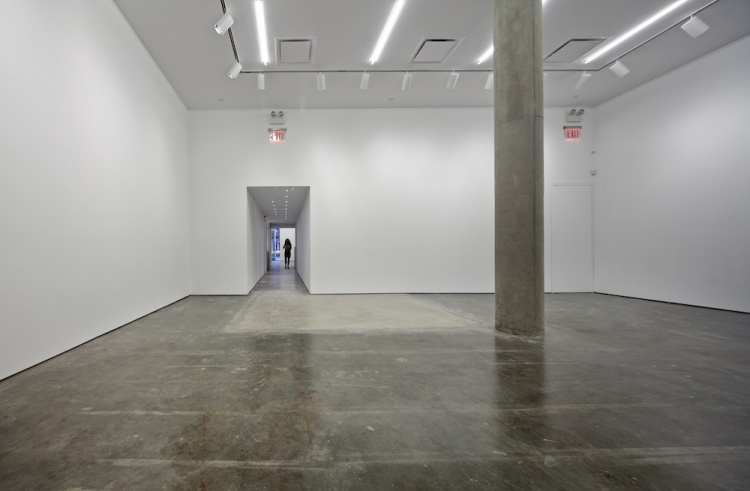
Yossi Milo Gallery Interior, 2012. ©Esto/David Sundberg.
J. Carino
Carry It With You
June 26, 2025 - August 22, 2025
Yossi Milo is pleased to announce J. Carino’s debut solo exhibition with the gallery, Carry It With You, which opens to the public on Thursday, June 26, 2025. The exhibition will be on view in the East Gallery through Friday, July 25, concurrent with solo exhibitions by London Williams in the West Gallery and Beck Lowry in the Qube.
J. Carino’s (b. 1988; Littleton, CO) paintings examine humanity’s relationship to the natural world, and further a queer perspective through sweeping, sensual vistas of body and landscape. Through portrayals of nude subjects out in the open, Carino takes a stance of peaceful transgression and resists societal constraints placed on queer people, on masculinity, and on nature all at once. The artist draws heavily from the terrain of the American West in his visual language, recognizing his home territories of Colorado and California as loci of nature’s power. In Carry It With You, Carino joins together the individual tableaux of his paintings to create a single visual epic: a tale of paradise, cataclysm, and hope that positions queer people as the main actors in a new American myth.
The story of Carry It With You begins in a pastoral and bucolic frontier, where Carino’s subjects live in communion with the land and with one another. The Futurist-tinged “Eden” and expansive “Peaceable Kingdom” show a society in repose as figures lounge, embrace, and bathe; relaxed and seemingly unaware of a specter looming in the wings. This world takes inspiration from Riverside, California, where Carino lives today. The wild donkeys that accompany the artist’s figures reference those that live among the canyons near his home. Originally brought Westward as work animals, they roam the hills today in a “natural” state; newly wild, yet not endemic.
The peace of Carino’s realm is short-lived, torn by floods, fires, and movement seemingly unleashed from everywhere at once. As disaster rocks Carry It With You, so deepens its parallels to the environmental shifts faced by communities in California and beyond, as well as its allegory for the global precarity of LGBTQ safety. Carino’s men gather bundles of wood and flowers, rescuing vulnerable animals from rushing waters as they flee. These figures find space for care within the distress of this upheaval — in “Flood,” one figure scoops up a foal from a rushing stream; “Carrying Beauty” shows a mournful figure who scatters wildflowers behind him as he moves. Here, humanity is shown reckoning with nature’s will and with their own impact on the landscape, bearing the load of responsibility for how their surroundings have changed.
“New Beginnings” and “After the Flood” offer a glimpse at renewal, tinged with warm tones that signal the dawn of a new era. After this arduous journey, Carino’s society finally replants the seeds of peace, establishing a new home amidst a changed landscape. Together, these anonymous figures rebuild their utopia and reconstruct their relationships with nature and one another, and, with hope, build towards lasting peace.
Carry It With You navigates a world of shifting visual references, evocative of the churn of a modern disaster-focused news cycle. The peace and chaos in these paintingsis conveyed through a collision of styles: a sublime dissonance of Japanese ukiyo-e waves, Art Nouveau patterning, Regionalist forms, and Expressionist texture. The central thread in this global quilt of histories are 1930s New-Deal-era murals, especially those commissioned by the Works Progress Association. Often, these murals depicted soldiers, farmers, and workers as the players in a one-sided narrative of America’s founding — a perspective Carino challenges while echoing their capacity for storytelling. Carino’s “American Progress,” the climax of Carry It With You, shares its title with an 1871 work by John Gast, whose notion of progress is inverted: where Gast showed pioneers driving railroads and electric wires Westward to new frontiers, Carino shows an Eastward movement of dismantling, recovery, and escape. This community rallies a procession against their erasure, reframing “progress” as gestures of tenderness and protection as they move towards a peaceful land visible in the distance. In this way, Carino’s narrative finds its resolution through healing over conquest; community over division.
Across the works on view, Carino muses on what queer people carry with them: the simultaneous burden and provision of queerness itself. Sticks and wood are bundled into faggots for building and for kindling; a cheeky and sincere simile the artist invokes for the ways queer people gather to create pleasure and possibility. The artist invokes this notion of community in response to a rising sense of anxiety — of urgency around climate change and the erosion of legal protections for LGBTQ people. In the face of uncertainty, Carino looks for ways to hold space in a landscape that seems to constantly shift underfoot. This intertwined narrative of humanity and nature reframes calamity and disarms fear, asking audiences to look past the horizon, towards which they carry all they need to build utopia.
J. Carino has presented solo exhibitions at Rhodes Contemporary, London, UK; Monya Rowe Gallery, New York, NY; Sow & Tailor, Los Angeles, CA; Monti 8, Latina, Italy; and Auxier/Kline, New York, NY, among others. Carino has presented work in group exhibitions at James Cohan Gallery, New York, NY; Vardan Gallery, Los Angeles, CA; Nazarian / Curcio, Los Angeles, CA; and BEERS, London, UK, among others. The artist participated in residencies at the Art House San Clemente Residency, CA, in 2023; and PM/AM, London, England, in 2024. A painting by Carino recently joined the permanent collection of the Bakersfield Museum of Art, CA. The artist holds a BFA from Parsons School of Design. Carino lives and works in Riverside, CA.
London Williams
Poetics
June 26, 2025 - August 22, 2025
Yossi Milo is pleased to announce London Williams’ first solo exhibition with the gallery, Poetics, which opens to the public on Thursday, June 26, 2025. The exhibition will be on view in the West Gallery through Friday, July 25, concurrent with solo exhibitions by J. Carino in the East Gallery and Beck Lowry in the Qube.
London Williams (b. 1998; Milwaukee, WI) immerses his audience in a constructed world, where he posits a sartorial vision of a Black, queer utopia. Williams’ multi-media act of fantasy is speculative, patchworked from domestic interiors that build a new space for him and his subjects to call home. The artist’s realm unfolds room by room, inviting viewers to enter an elliptical world of parlors, dance halls, and dreams.
Poetics presents several monumental paintings by Williams that are stretched onto the walls by crystal-tipped upholstery pins. Depicted at near-life size, the figures inhabiting these works transcend their role as subject, becoming more akin to performers of a wordless drama. These works operate on the bodily scale of Renaissance paintings and religious murals, making use of the same relationship between subject and audience that inspires devotional awe or fear — here, inverted by Williams into tenderness. Many of the figures take their likenesses from the artist’s community, especially of the ballroom scene of Pittsburgh, whose undeniable presence adds to the poetics and emotional tenor of the works on view.
Interactions between Williams’ subjects play out in semi-private spaces, sharing intimations of care and desire in glances and whispers. Clad in smart suits, cowboy hats, and high heels, these figures index a look that toes the line between masculine and feminine, taking their cues from the archetype of the dandy. Their polish signals their agency, an embodied act of esteem and resistance. The historic significance of poised, intentional presentation emerges through careful acts: tying one another’s bow ties; exposing an undershirt; glancing sidelong under the brim of a hat.
Some of these works deliberately invoke a bygone era, rendered in a muted palette of graphite and burnt umber that recalls daguerreotypes or silver-plate photographs. These paintings take on the aged imperfection of vintage imagery, picturing a past rich with double exposures, cutouts, and collaged scraps. In imitating photography, these works implant a fictional memory, leaving a residue of the spectral energy Williams calls on in his work. This intentional patina is a testament to an invented past life — for a camera to have recorded anything, it must have been present.
In its narrative capacity, Williams’ work channels the undefined and subtle qualities of editorial spreads, taking cues from their staging, wardrobe, and the exaggerated acting of high-fashion poses. At the same time, the artist questions fashion photography’s adherence to exclusivity— its sameness, whiteness, and class structure. The artist probes the conflicting relationship between iconography and life, relating it to his religious upbringing in the Midwest. Williams shares: “In Milwaukee, where I grew up, I saw Black congregations overseen by white angels.” Ballroom, too, destabilizes the unattainable within fashion and glamour, animating bodies through vogue or granting a surname like Balenciaga, Mugler, or, as in Williams’ own kiki house, Baby Phat. The reclamation of self-image through depiction is more than a motivation: it becomes a new identity unto itself. In his work’s billboard-like scale and grand intention, Williams occupies and transforms space, and makes it his own and his community’s.
Emerging in a flash of vivid club lighting, Willaims’ painting “The thought of the height of the heels he would wear to his fathers funeral,” (2025) finds its subject alone, staring over his shoulder at the viewer as though the surface of the work itself were his mirror. His hand at his glittering ear, feet apart, he grounds his resolution in the height of his thigh-high boots, no different to the power found in blazers, slacks and ties elsewhere in the exhibition. Williams directs his models to channel their emotional states in their poses, which he reflects outwards into the paintings themselves. This encapsulates Williams’ exploration of the Black queer psyche — in his own words, “the poetics of the butch queen.” In having built a conceptual new home for these subjects, draws this practice away from pure depiction and towards fantasies of sanctuary.
A meta-narrative unfolds in Williams’ work on the relationship between image construction and life. The amorphous settings of the artist’s paintings are reminiscent of homes, clubs, and the proverbial studio in which they are made. Williams, like artists across history — from Diego Velázquez to Mickalene Thomas — shows the studio as a proscenium to the image, a subjective framing device for a vision at once imaginary and grounded. The artist views his own studio as a sacred space, wherein his fellow dancers and artists become archetypal muses, celebrated and written into a centuries-long painting tradition. Williams takes authorship over the ties between painting and life, crosses from fabulation to fabrication, and builds monuments to the butch queen.
London Williams’ work has been exhibited at Yale School of Art, New Haven, CT; Platform Gallery, Pittsburgh, PA; Miller Institute for Contemporary Art, Pittsburgh, PA; Haw Contemporary, Kansas City, MO; San Dao Gallery, Wuhan, China, and DooSung Paper Gallery, Seoul, Korea. The artist is a 2024-25 artivist with 1Hood Media Academy, Pittsburgh, PA; and a 2024-25 artist-in-residence with the Brewhouse Arts Distillery Emerging Artists Program, Pittsburgh, PA. Williams has received recognition through grants by the Pittsburgh Foundation, PA, and the Elizabeth Greenshields Foundation, Montreal, Canada. In 2019, Williams was an Andrew W. Mellon Curatorial Fellow in Photography at the Nelson-Atkins Museum of Art, Kansas City, MO. Williams earned a Bachelors in Fine Arts in painting from the Kansas City Art Institute, MO, and a Masters in Fine Arts from Carnegie Mellon University, and lives and works in Pittsburgh, PA.
Beck Lowry
First storm
June 26, 2025 - August 22, 2025
Yossi Milo is pleased to announce Beck Lowry’s first solo presentation with the gallery, First storm, which opens on Thursday, June 26, 2025. The exhibition will be on view in the Qube through Friday, July 25, and is concurrent with solo exhibitions by J. Carino in the East Gallery and London Williams in the West Gallery.
Beck Lowry’s (b. 1980; New Haven, CT) wall-hung sculptures combine carved, woven, and painted elements in experimental, process-driven forms. The artist navigates their hybrid approach through intuition, taking visual cues from the natural world and improvising on techniques drawn from a global canon of craft. Lowry’s multimedia practice hinges on its relationship to the body, becoming charged with meaning through almost-ritualistic physical exertion and the highly laborious nature of craftsmanship itself.
Each of the artist’s painted weavings begins with a spine- or ladder-like armature, carved from plywood, that serves as the support for a woven plane of thread and fabric. The resulting irregular, undulating surface becomes a site for Lowry’s instinctive oil paintings, which take cues from proximate landscapes, the sublime aspects of nature, and humanity’s relationship to it. The artist enshrines each painting in an ornate frame, which is carved and shaped around it before the finishes are put on the entire work together. This concentric process further blurs the distinction between discrete traditions of painting and sculpture and gestures toward a nuanced third category of cross-medium making.
The titular “First storm” draws on Lowry’s recollections of squalls and tempests, alluding to the expansive sea and swirling winds in an abstracted landscape. Though the work draws on the artist’s specific memories of family and the Long Island Sound, its gyres rendered in blue and yellow allude to a universal relationship to the sky, a deference to nature’s awe-inspiring power. Without words, the artist conveys a narrative that is at once personal and primordial.
By working in distinct phases of highly physical creative labor — carving, weaving, painting — Lowry references a ceremonial dimension, wherein emotional significance is imbued through regimented time and effort. In the studio, the artist relishes each stage, making clear their fascination with technique and texture in the form of carved marks, recursive pattern, and tactile fibers. Descended from a family of makers, Lowry considers the act of creation a central aspect of their identity.
Lowry’s works imagine a global practice of craft freed from geography and function, where the artist navigates the ego and body as dual motivations to create. In this way, Lowry calls into question the anonymity of craftspeople whose artifacts persist as objects of study, yet whose identities are lost to posterity. By recognizing the ways objects wordlessly convey emotion and spiritual meaning, Lowry questions the positioning of craft as a product of the past and weaves threads of folk practices into new forms.
Lowry’s work has been exhibited at Morgan Lehman Gallery, New York, NY; Elijah Wheat Showroom, Newburgh, NY; Headstone Gallery, Kingston, NY; Lyman Allyn Art Museum, New Haven, CT; Ely Center for Contemporary Art, New Haven, CT; and Delaware Contemporary, Wilmington, DE. Lowry is a 2024-25 resident of the Sharpe-Walentas Studio Program, Brooklyn, NY; and has participated in residencies at Interlude, Kingston, NY; and Millay Arts, Austerlitz, NY. Their work has been covered in Artforum, New American Paintings, Maake Magazine, and Galerie. Works by Lowry are held in the public collections of Southern Connecticut State College, New Haven, CT, and Gateway Community College, New Haven, CT. Lowry holds a Bachelor’s Degree in Economics and a Certificate in African Studies from Smith College, Northampton, MA. The artist lives and works in Connecticut.
Alexa Guariglia
Act Natural
May 1, 2025 - June 21, 2025
Yossi Milo is pleased to announce Alexa Guariglia’s debut solo exhibition with the gallery, Act Natural, which opens to the public on Thursday, May 1, and will be on view through Saturday, June 21, 2025.
Alexa Guariglia (b. 1990; New York, NY) deploys watercolor, gouache, and ink on the surfaces of her works on paper, sensationalizing daily life in gestural forms and precise zones of pattern. Observing her surroundings with an earnest, anthropological eye, Guariglia animates fragments of memory into compositions of urban and collective space. The artist pursues this in small-scale, individual portraits and vast scenes with grouped ensembles of figures, all of which are grounded as deeply in optimism, style, and humor as in embellishment and sheer detail in pursuit of the sublime.
In Guariglia’s practice, pattern is essential, taking center stage as both a universal method of adornment and a metaphor for the organizing principles that create beauty within a chaotic world. Patterns seen in nature, both visual and behavioral, arise from unconscious repetition and variation. For Guariglia, to Act Natural is to follow and study these, and to be guided by a social cue as intuitively as her paintings follow her hand. This approach to rendering is informed by the principles of calligraphic mark-making and the artist’s own experience painting signs and murals in her youth. Reconfiguring the simple, yet infinitely variable practice of lettering, Guariglia makes use of the same curves, diagonals, and straights that make up the symbols of language. In this way, painting becomes a coded form of communication, a method by which the artist articulates human truths with economy of line. Improvised in dancerly brushstrokes across each subtly irregular piece of paper, Guariglia drafts wordless poems on life in the city.
As a product of self-awareness, Guariglia takes particular note of the behavior of others: schedules, divisions, routines, rewards. Through her work, the artist recognizes these as the substance of social life and the scaffolds of sentimentality. Checkers, zigzags, houndstooth, and dots act as product and metaphor, exemplifying the tender pull of the day-to-day while being derived directly from it. Each of Guariglia’s tessellations is born from her own capacity for pattern-recognition, drawn from a deep mental library — of vintage prints, decorated rooms, and places past — that are richly interpolated into the artist’s imagined spaces and characters.
This process comes full-circle in Guariglia’s extravagant large-scale works, where depth and volume arise from the impact of countless microcosms within broad and graceful shapes. In these scenes, the artist’s figures display parallel actions and patterns of behavior that underpin and echo the designs that unite them. “Limelight” (2024) is a scene within scene, wherein a film set depicting New York is lit and shot by a foreground of studio workers in Los Angeles. Their concentric arrangement creates a world within a world: one where figures act, and another where they act natural. Two figures at the front frame the action, arabesque in conversation; the middle ground shows the set crew, each smartly dressed in swirls, damasks, and bows. A black-and-white beam signals the camera’s view through a deft switch into ink wash, and just to its right appears a tiny figure polishing up the familiar Nathan’s sign. As in many of Guariglia’s immersively-sized paintings, the periphery is a harmonious clash of print and color.
Visual principles of embellishment and contrast lead Guariglia’s dramatizations of public space, where she finds miniature universes within shared places: libraries, department stores, post offices, theaters, salons, and parks, to name only a few. The individual elements of each painting are created through a constancy of change, and gouache and watercolor bump elbows with pencil and ink in creating dimension. In engaging deeply with paper and varying her approach, Guariglia finds a union of drawing and painting that is bound to paper’s permanence and freed by its immediacy. This dichotomy creates her work’s tactile appeal: the surface of each painting recalls Medieval illuminated manuscripts as readily as exotic textiles through its vibrant tones and highly ornamented charm. In her studio, the artist zooms into granular ideas and narrative details to reveal the lyricism within the overlooked. In Act Natural, Guariglia finds a balance between looking backwards into memory and forwards to possibility, using the ordinary as a site of inquiry into the unknown. Immersed in the dazzle of Guariglia’s work, her viewers — much like her subjects — are natural beings who take in their unnatural environments with open curiosity, always seeking a hint of what might come next.
Act Natural is Alexa Guariglia’s first show in New York since 2020. Guariglia has presented solo exhibitions at Moskowitz Bayse, Los Angeles, CA; Gallery 263, Cambridge, MA; and World’s Fair Gallery, Providence, RI. Works by Guariglia have been included in group exhibitions at Galeria Mayoral, Paris, France; Fourth Wall, Boston, MA; Kevin Porter, Boston, MA, among many others. Her work is held in the permanent collection of the Rose Art Museum, Waltham, WA. The artist studied painting at The School of the Museum of Fine Arts, Boston, MA. Guariglia lives and works in Providence, RI.
Sarah Anne Johnson
A Mountain and a Forest
March 13, 2025 - April 26, 2025
Yossi Milo is pleased to announce Sarah Anne Johnson’s second solo exhibition with the gallery, A Mountain and a Forest, which opens to the public with an artist’s reception on Thursday, March 13 from 6-8 PM, and will be on view through Saturday, April 26, 2025.
Sarah Anne Johnson (b. 1976; Winnipeg, Manitoba, Canada) explores the natural world through sensation and perception, and centers depictions of these internal experiences in a multimedia record across varied series that span photography, video, and sculpture. In A Mountain and a Forest, Johnson continues to innovate on the approach of her ongoing series Woodland, in which the artist alters photographs of the wilderness through digital color, oil paint, metal leaf, and holographic tape, among other media. Through these invented hues and textures, Johnson translates her wonder at the landscape into the visual realm and creates artworks that capture more than what can be seen through the camera alone.
A Mountain and a Forest presents two new bodies of work by Johnson: Cedar Forest, a vibrant series that grows out of Woodland; and Mountain, which presents altered photographs of a remembered wilderness excursion in hand-sculpted frames. Together, these series locate humanity’s place within Johnson’s vision of the North American wilderness and pay homage to the splendor of Canada’s Western frontier.
In early 2020, Johnson created her Woodland series as a reaction to a collective sense of isolation and disconnection. Through this work, the artist sought a resonant source of joy in color and nature. In Cedar Forest, this practice moves geographically Westward from Johnson’s home region of Manitoba to the cedar forests of British Columbia. Johnson compounds her change in horizon with an expanded field of view, emphasizing stands of cedar trees over any one individual, which glow from within through an intensified use of color. This visual overgrowth nods to the connections that ground Johnson’s work — both between humans and the landscape, and in natural relationships that make up the ecosystem itself. In cedar forests, the oldest trees are known as “mother” trees, which communicate and share resources with the surrounding forest through a mycelium network. In Cedar Forest, the artist honors the potential of this non-human consciousness: the idea that there are unseen signals and intelligence between trees that exist underneath the sounds and sights of forests.
As the titular subjects of Cedar Forest, trees take center stage, and Johnson’s activations of their architectural forms give them an inviting, psychedelic energy. “Purple Stump (Cedar Forest)” (2025) is ringed by sunset tones, spangled with fragments of holographic tape; “Pink Secret (Cedar Forest)” (2025) draws the viewer towards a glade of neon radiance at its center. In many Cedar Forest works, Johnson locates the sun through the trees and digitally augments its rays, alluding to a euphoric enlightenment and the simple, yet profound pleasure of the outdoors.
This awe is counterpointed by sentimentality in the sculpturally-framed photographs that make up Johnson’s new series Mountain. Each work is comprised of images of the artist’s friends on a seven-day hiking, camping, and horseback riding expedition into the wilds of Jasper National Park, Alberta, Canada. In creating the frame for each of these prints herself, Johnson brings together her sensibilities across media and envelops each memory in a textural portal of the artist’s design.
Johnson digitally manipulates the images in Mountain and traces forms across them in oil paint, changing spectrum between black-and-white and color. These shifts allude to time’s passage, and the works flit between past and present to share in the artist’s memories and their echoes. By Johnson’s hand, a sunbeam or figure will emerge, illuminated as the emotional core of the scene. Especially in greyscale, Johnson’s casual snapshots recall the work of figurehead twentieth-century photographers and environmental advocates, imbued with an off-the-cuff and affectionate air.
The grand and tender vistas in A Mountain and a Forest posit a journey towards the sublime, a narrative where Johnson’s practice acts as a motivation and a destination. The figures of Mountain journey ever-onwards, captured en route towards the salvation found in the forests of Cedar Forest. The images in Mountain were captured during a trip that took place before Johnson began her Woodland works, and their presentation alongside the growth of that series into Cedar Forest marks a full-circle step in the artist’s practice.
Sarah Anne Johnson’s work is held in permanent collections across the globe, including the Metropolitan Museum of Art, New York, NY; Solomon R. Guggenheim Museum, New York, NY; Phillips Collection, Washington, D.C.; North Carolina Museum of Art, Raleigh, NC, and Canadian Museum of Contemporary Photography, Ottawa, Canada, among many others. Johnson's monumental 6-channel video installation “The Kitchen” (2016) joined the Hirshhorn Museum and Sculpture Garden's permanent collection in 2022, and in 2024, a large-scale triptych, “MBFR” (2021), was acquired by the National Gallery of Canada, Ottawa, Canada. A work by Johnson was featured in a central role in the 2024 film The Idea of You starring Anne Hathaway. Her work has been featured in numerous prestigious group exhibitions, such as those at the New York Public Library, New York, NY; Yale University Art Gallery, New Haven, CT; Art Gallery of Ontario, Toronto, Cananda; Musée des Beaux-Arts de Montréal, Canada; Massachusetts Museum of Contemporary Art, North Adams, MA; Anchorage Museum, Anchorage, AK; Musée International des Arts Modestes, Sète, France, and Taubman Museum of Art; among others. Johnson received her BFA from the University of Manitoba and her MFA from Yale University. The artist lives and works in Winnipeg in Manitoba, Canada.
John Gill
WHAT DO YOU WANT TO BE?
March 13, 2025 - April 26, 2025
Yossi Milo is pleased to announce a solo presentation of new and recent dynamic ceramic works by John Gill, WHAT DO YOU WANT TO BE?, which opens to the public on Thursday, March 13, with an artist’s reception from 6-8 PM, and will be on view through Saturday, April 26, 2025.
John Gill (b. 1949; Renton, WA) has been celebrated in the field of ceramics for over half a century, and has long staked his work on the vessel as a starting point, creating endless variations on vases, ewers, bottles, and platters. Gill embraces postmodern levity over discernible functionality, and the resulting works take utility only in name. In this pursuit, Gill focuses on building ceramic volume by joining together and manipulating innumerable clay slabs, and each work manifests in a joyful collision of color, texture, and raucous form.
Gill constructs these using a time-tested hand-building method, joining and molding flat shapes to make the angular and undulating body of each work. This instinct-driven approach comes as a negotiation between the artist’s will and his medium. “I hate to just execute a piece,” Gill states, “instead I ask the clay, what do you want to be?” Guided by pure intuition, the artist finds shape within elemental earth, which he then illuminates with an effervescent array of colors. In stages, each vessel is transformed from wet clay to once-fired bisqueware, which is glazed and fired again to reach completion. “I have to make every work twice,” states Gill, “once when I build the vessel, and another time when I color it.” Each of Gill’s works belies the process of its making, seeming to burst into existence fully formed.
This presentation includes a grouping of monumental vases and covered jars, created over the past three years. These vessels are intricate inside and out, and architectural grandeur on a miniature scale is hidden away within their jubilant exteriors. Especially in his larger open forms, Gill approaches his work from every possible angle, rotating it as though in zero gravity and building it without a defined top or bottom. In the case of his jars, once they finally come down to Earth, the artist completes them with precise-fitting, highly ornate lids. Gill’s closed forms create new private spaces and invoke a distinct utility within his lexicon of subverted purposes: to conceal. The inside of the jar becomes a secret, its unseen volume now enclosed.
On the outside of each work, Gill stretches textures and color out onto space, blending art historical lineages with aplomb. The artist especially looks to painting for inspiration, and takes in his surroundings as a painter might to inform his use of light and color in three-dimensional space. Gill’s ceramics synthesize the natural world through diverse schools of thought, employing sensibilities that range from Impressionist to Pop, from Fauvist to Abstract Expressionist. The rugged stepped forms on the outside of one of Gill’s jars could be as easily traced in the carved staircase of an ancient temple as they could be in those of a painting by Marcel Duchamp; the wobbling, graceful curve of a vase’s belly could be as inspired by a river basin as it could be by Stuart Davis’s flattened painted forms. In constantly colliding angular and soft, vibrant and quiet, Gill’s works walk a path that balances tradition and innovation to moving effect.
ABOUT THE ARTIST
John Gill's work has been widely exhibited in the United States and abroad, including at the Metropolitan Museum of Art, New York, NY; Denver Art Museum, Denver, CO; Pottery Workshop, Shanghai, China; and Kraushaar Gallery, New York, NY. The artist's work is held in the collections of the Victoria and Albert Museum, London, UK; Metropolitan Museum of Art, New York, NY; Los Angeles County Museum of Art, Los Angeles, CA; Brooklyn Museum, Brooklyn, NY; Rhode Island School of Design Museum, Providence, RI; and Newark Museum, NJ, among others. In 2008, Gill was inducted into the International Academy of Ceramics in Geneva and was elected a Fellow at the American Crafts Council in 2014. In 2018, he received the James Renwick Alliance Distinguished Craft Educator Award. The artist lives and works in Alfred, NY.
Alina Perez
Family Romance
January 16, 2025 - March 8, 2025
Yossi Milo is pleased to announce Family Romance, Alina Perez’s first solo exhibition with the gallery. Family Romance opens to the public on Thursday, January 16, with an artist’s reception from 6-8 PM, and will be on view through Saturday, March 8, 2025.
Alina Perez’s (b. 1995; Miami, FL) drawings operate on a psychic plane, using an internal emotional logic to create scenes that are altogether new. Using imagination as a plan of action, Perez alters her own closely held recollections to compose surreal tableaux. The artist’s path forward is far from linear, diverting into scenes of tenderness, violence, and eroticism in a search for resolution. Perez’s drawings act as portals; glimpses of alternate and parallel realities in which the artist gives form to emotional sensation and recognizes the true power of fantasy.
In Family Romance, Perez escalates this practice towards pivotal personal experiences. The artist’s revisitations of critical memories change their dynamics alongside their content, and across the exhibition, hierarchies of familial and romantic relationships expand, shift, and collapse at will. Especially in weighing the aftershocks of trauma, Perez questions the effects of secrecy, complicity, and disclosure, upending them to find sources of power that motivate her work.
The physical world takes newly charged forms in Perez’s practice, and the artist engages deeply with the surroundings and traumatic encounters of her youth in Miami, Florida. Across Family Romance, the artist, her relatives, and loved ones take on new shapes and meanings alongside elements of Floridian urban life and nature. The poetics of the state’s ecology are rife with their own environmental tensions, being at once rich and fragile, precious and endangered, invasive and endemic; Perez positions these as parallel to those of human psychology. The fragility of a landscape like the Everglades is much like that of a young mind; possessive of a conjoined depth and vulnerability.
In Perez’s realm, nature is an actor unto itself, playing a sentient role among its human inhabitants. Approaching each work intuitively with charcoal and pastel, the artist renders figures that meld, metamorphose, and concretize subconscious feelings through elements of the natural world. Figures sprout claws and feathers, and bodies take on the same malleability Perez imposes on memory. In “Stress Induced Flowering” (2024), a figure exits a bathroom in a state of half-dress, stepping past the midsection of a python that similarly passes from room to room — a doubled liminality. Perez’s surreal intensity lends seemingly mundane objects gravity by contrast: a tiny pair of ceramic figures preside over the comparatively intimate yet disquieting interaction within “Precious Moments” (2024). The touches of the “real” carry the weight of the past with them, while the surreal furthers the revisionary capacity of the psychic world. Perez destabilizes memory as a process solely of recreation, instead acknowledging the simultaneous freedoms and dangers of the inner realm as a site for possibility. The artist represents the inherent power of these metaphysical forces, showing the capacity for fantasy to articulate and shape reality.
Emotional tenor and acute reaction are made physical through the artist’s use of dry media; paper holds the memories of preceding marks, and layers of opaque pigment build and ebb to form the surface of each work. Perez shifts in speed and approach between precise, dimensional rendering and liberated materiality, acting as a narrator who changes in affect between each drawing. Perez’s hand scrapes and scratches towards the edges of her works, fanning out from dense centers into delicate webs of pigment, as though the space of each drawing could join edge-to-edge and blend together.
Finding power in liminal states and confluences of charged feelings, Perez uses metaphors of nature to dissolve and complicate boundaries between emotions. Across Family Romance, simultaneity and tension are represented by the artist through acts of transformation. Mutation, growth, and change represent how, through imagination, it becomes possible to exist in more than one state at a time. In a refusal of one-dimensional readings of trauma, sensuality, or vulnerability, the artist expands complex and relational dynamics of gender. Transformation represents an embodied queer experience, processes of becoming, and reconciliation with the confines placed on developing individuals. In Perez’s realm, people can be anyone and anything: children, adults, women, men, animals, plants, lovers, monsters, and forms of land and sea. Rejecting binaries and essentialist readings, the artist instead finds possibility within.
Family Romance coincides with the inclusion of Alina Perez’s work in Flow States – LA TRIENAL 2024, the second triennial survey of contemporary Latinx art held at El Museo del Barrio, New York, NY. Flow States is on view through Sunday, February 9, 2025. Perez’s work has been exhibited at the Taubman Museum of Art, Roanoke, VA; the Tegner Museum, Copenhagen, Denmark; Atlanta Contemporary, GA; Arcadia Missa Gallery & Publishers, London, UK; Deli Gallery, New York, NY; James Cohan Gallery, New York, NY; Rachel Uffner, New York, NY; Company Gallery, New York, NY; and M+B, Los Angeles, CA. In 2017, Perez was a resident at the Skowhegan School of Painting and Sculpture, Madison, ME, and has attended residencies at the Fine Arts Works Center in Provincetown, MA, the Ox-Bow School of Art, Saugatuck, MI; and the Vermont Studio Center, Johnson, VT. The artist received her BFA in Painting from the Rhode Island School of Design and her MFA in Painting and Printmaking from the Yale School of Art. The artist lives and works in New York, NY.
Anoushka Mirchandani
A House Called Tomorrow
November 14, 2024 - January 11, 2025
Yossi Milo is pleased to announce A House Called Tomorrow, Anoushka Mirchandani’s (b. 1988; Pune, India) debut solo exhibition in New York and first with the gallery. A House Called Tomorrow opens with an artist’s reception on Thursday, November 14 from 6-8 PM, and will be on view through Saturday, January 11, 2025.
You are not fifteen, or twelve, or seventeen— / You are a hundred wild centuries // And fifteen, bringing with you / In every breath and in every step // Everyone who has come before you, / All the yous that you have been, // The mothers of your mother, / The fathers of your father.
- Alberto Rios, “A House Called Tomorrow”
A House Called Tomorrow, which shares its title with a poem by Alberto Rios, is presented at a pivotal moment for Mirchandani. The exhibition coincides with the artist’s relocation to New York after more than a decade in California—a move that marks the beginning of a transient chapter in her life and parallels her experiences of immigrating from India as a young adult. Using autobiography as a window, Mirchandani negotiates how architectures of space, self-image, and relationships evolve across shifting socio-political landscapes. The artist manifests this in paintings that depict herself and her loved ones, and draw connections between a deep familial archive and her life in the present.
In A House Called Tomorrow, scenes from the artist’s life in California and India appear alongside public parks in New York City; other works in the exhibition venture abroad to villages in Italy and the dense tropical forests of Brazil. Through these hyperlocal landscapes of personal importance, Mirchandani summons a psychic space that traverses land and time. This interior world is motivated by tumultuous feelings of nostalgia and loss that give way to hope, comfort, and agency. Previously, Mirchandani’s subjects appeared alone in solitary explorations of the self— but, as the artist’s horizons have grown through her recent move and subsequent travels, so have the roles of her subjects. Joining one another in community on the canvas for the first time in years, figures in Mirchandani’s new works expand social notions of love, intimacy, and care in the company of one another. Abstracted bodies blend and merge into natural land masses and architectural space, embodying a cyclical process of discovery and remembrance. In Mirchandani’s raw jungle works, she takes on positions of sensuality and strength in self-portraits that confront the viewer head-on, one-on-one in the wilderness. In doing so, she reclaims power from the trope of the “wild,” embracing herself through forays into the unknown.
Mirchandani’s figurative interplays of line and shape alternate between sinuous outlines and solid forms, which create a pictorial parallel to social notions of code-switching in language and affect. The artist’s figures build their own emotional space, one where place-making comes as the result of an intuitive process rather than a physical one.
Among the new works included in A House Called Tomorrow is “You see, I've forgotten / if they're brown or they're blue” (2024), in which Mirchandani brings these notions of interpersonal connection and pictorial metaphor to the fore. The work’s two subjects hold hands, seated in an interior space. The central figure’s body weaves in and out of transparency, and the environment comes in and out of focus through her. The environment can be viewed through her like a lens, and she conversely exists as an inherent force that shapes it. Mirchandani makes a visual metaphor of this conversation between the individual and her recollection, rendering the two through one another, and allowing viewers to see both simultaneously. These changes in approach mirror the situationally evident and hidden parts of her subjects, creating a representation of the internal experiences of alienation, belonging, and remembrance.
The shifting conceptual and emotional undercurrents in Mirchandani’s work arise from her varying memories of relocation. The artist’s move to New York echoes stories of the many migrations—both voluntary and involuntary—from her matrilineal heritage, and relates to experiences of motion and transience broadly. In 1947, Mirchandani’s grandparents faced their own forced relocation during the partition of India, when they fled to India from the region that eventually became Pakistan. These recurring narratives motivate the artist’s investigations into the constant loss and reclamation of the self, and into resilience, adaptation, and agency. A House Called Tomorrow raises the stakes of Mirchandani’s search for community and for a literal and figurative sense of stability in her own increasingly migratory existence. In bridging seemingly disparate worlds, Mirchandani finds a decentralized form of place-making that transcends geography to welcome new ways of becoming.
Anoushka Mirchandani is a multi-disciplinary artist who has mounted solo exhibitions at Galerie Isa, Mumbai, India; UTA Artist Space, Los Angeles, CA; Rhodes Contemporary Art, London, UK; and Glass Rice Gallery, Los Angeles, CA. Mirchandani has exhibited internationally in group exhibitions at Bode, Berlin, Germany; Legion Projects, Heraldsburg, CA; Knowhere Art Gallery, Martha's Vineyard, NY; 111 Minna Gallery, Root Division, and Arc Gallery, San Francisco, CA. The artist received a grant from the San Francisco Arts Commission in 2022, and has been an artist-in-residence at Wassaic Project, NY; Global Coralition, Sosua, Dominican Republic; KYTA, Ladakh, India; and Aegean Idea Lab, Paros, Greece. Anoushka Mirchandani earned her BA from Denison University, and studied painting at City College, San Francisco, CA. The artist was born in Pune, India, and currently lives and works in New York, NY.
Cameron Welch
Labyrinth
September 6, 2024 - November 9, 2024
Yossi Milo is pleased to announce Labyrinth, a solo exhibition of new mosaic works by New York-based artist Cameron Welch (b. 1990; Indianapolis, IN). The exhibition opens with a reception on Friday, September 6 from 6-8 PM, and will be on view through Saturday, November 9, 2024. Labyrinth is Welch’s second exhibition with the gallery, and coincides with the release of the artist’s debut monograph Mosaics, co-published by Radius Books and Yossi Milo.
Built around mazes, spirals, and garden motifs, the exhibition reframes the chaos of contemporary life through tropes and stories from ancient art history, taking the Labyrinth as both its theme and structure. The frenetic scenes Welch creates — made up of thousands of pieces of hand cut marble, stone, ceramic, and glass — cast a collision of modern and archaic elements that unfurl within the mire of an unruly garden maze. The artist’s material and literary combinations result in a distinctive pictorial intensity, a visual language whose commotion mirrors that of the modern era. Continuing his exploration of contemporary tumult through story and archetype, the artist hones his focus on the meandering paths of the mythical Labyrinth as a setting for this new body of work.
In ancient Greek legend, the Labyrinth was an ingenious maze designed by the architect Daedalus to house the Minotaur, a monstrous half-man, half-bull creature. Theseus, the heroic prince of Athens, volunteered to enter the Labyrinth of Crete to slay the Minotaur, and was gifted a spool of golden thread to follow his path through its winding passages. Referencing Theseus’s golden thread, Welch weaves spirals and tendrils across these new works composed of glass tesserae that are gilded with gold leaf, knotting together abstracted figures and scenes with their glimmering forms. This reference to ancient liberation becomes a guide through the twists and turns of the artist’s cacophonous world.
To be featured in Labyrinth is the new mosaic “Orpheus in the Garden” (2024), in which Welch places another Greek hero within this Edenic locale. The legendary bard, musician, and prophet Orpheus appears at the work’s center, surrounded by figments of the Underworld from which he sought to rescue his wife Eurydice. The surface of the mosaic is inlaid with innumerable twisting forms, repeating swirls that resemble Vitruvian scroll motifs and the distinctive spiral of the golden ratio. The work also shows the spiral forms of labyrinths that exist today as tools for meditation: flat, looping paths walked by those who seek tranquility through a circuitous journey. In this contemplative tool, the artist represents a reflective, winding path through the density of modern confusion.
In Welch’s hands, ancient history and mythology join the modern day in a synchronous view of time, and in this context the labyrinth takes on a similarly multivalent existence. The maze becomes a trap, a metaphor, and a tool by which awareness is achieved through change. Overgrown with plant life, tied with golden threads, and populated with heroes and monsters alike, Welch’s labyrinthine world is a place of confusion, yet it is also a space rife for growth and exploration.
ABOUT THE ARTIST
Cameron Welch's work has been exhibited at Gagosian, Beverly Hills, CA; Nino Mier Gallery, Los Angeles; Kavi Gupta Gallery, Chicago, IL; Harper’s Books, East Hampton, NY; Rental Gallery, East Hampton, NY; Jack Hanley Gallery, New York, NY; Jenkins Johnson Gallery, San Francisco, CA; Carl Kostyàl Gallery, Malmö, Sweden; and the Kunsthal KAdE, Amersfoort, Netherlands, among others. Welch presented his debut solo exhibition with Yossi Milo, RUINS, in 2022, which received a glowing review by Roberta Smith for The New York Times. Work by Welch is held in the collection of the Museum of Art, Rhode Island School of Design, Providence, RI, and The Nelson-Atkins Museum of Art, Kansas City, MO. The artist earned a BFA from the School of the Art Institute of Chicago, IL; and an MFA from Columbia University, New York, NY. Welch currently lives and works in Brooklyn, NY.
ABOUT MOSAICS
Mosaics is Cameron Welch’s debut monograph, co-published by Radius Books and Yossi Milo. The volume collects highlight mosaic works from across Welch’s oeuvre. An introductory essay by Alexis Belis, Assistant Curator of Greek and Roman Art at the Metropolitan Museum of Art, contextualizes Welch’s work alongside artistic practices from ancient history. Mosaics also contains an interview between Welch and painter Joel Mesler, who together discuss the creative process, the contexts of the art world today, and the evolution of Welch’s practice over the past several years.
Yale Painting and Printmaking MFA Class of 2024
SURFACE TROUBLE
June 27, 2024 - August 16, 2024
Yossi Milo is pleased to present SURFACE TROUBLE, a two-part group exhibition of artists from the Yale Painting and Printmaking MFA class of 2024. SURFACE TROUBLE will take place in two phases. The first part opens with a reception on Thursday, June 27th from 6-8 PM, and will be on view through Friday, July 19th, 2024. The second will open with a reception on Thursday, July 25th from 6-8 PM, and will be on view through Friday, August 16th, 2024. Featuring artists from the MFA program’s graduating class, SURFACE TROUBLE showcases a diverse set of approaches to the problem of painting as a contemporary medium, with a range of treatments and “troubles,” each as singular as the individual artists themselves.
The exhibition takes Cyborg Feminist Donna Haraway’s use of the term “trouble” in Staying with the Trouble as a jumping off point. In the text, Haraway states, “our task is to make trouble, to stir up potent response to devastating events, as well as to settle troubled waters and rebuild quiet places.” Amid times of trouble, the artists of SURFACE TROUBLE trouble their own forms. What is the role of image and surface at this time? What functions as the release of a societal pressure valve, and is it trouble itself?
—
SURFACE TROUBLE presents works emanating from multiple vantage points, a sectional survey of artists who are approaching the politics of everyday life and art historical precedent via research, abstraction, spirituality, technological critique, process, and figuration.
Many of the artists in SURFACE TROUBLE explore the technical aspects of what is called “painting” in the contemporary moment, while grappling with the state of the digital. Nadir Sourigi’s complex tiled works utilize meticulous methods of screening and masking to achieve disorienting yet pleasurable discrete units of aesthetic sensibility which reference the ever-shifting landscape of the internet, painting, and life. In her work, Haleigh Collins uses material contradiction and mimicry to challenge the legibility of process and painterly gesture. Each operation – spilling, embedding objects, silkscreening – speaks to a different sense of control and temporality.
The contemporary meaning(s) of process and painting – in tandem – are further extrapolated upon by several artists who engage with both the historic and aesthetic legacies of geometric abstraction, troubling the normative requirements of the category. Through a cross-disciplinary practice, Michael Cuadrado Gonzalez uses perceptual manipulation to rethink the formalism and propositions of universality endemic to the Modernist forces of the 20th century. Cuadrado navigates a “circuit of fraught desires,” examining his disidentifications with painting and the institutions which surround it through the lens of academics such as José Esteban Muñoz. Lauren Klotzman engages a geometric sensibility in the context of technological “process painting” within a media landscape saturated by electronics. In navigating both the synthetic and the organic, the painterly and the mechanical, Klotzman generates static paintings which are contrasting yet complementary “spin-offs” from a rigorous abstract and lens-less moving image process.
Laura Camila Medina works between painting and a complex video practice. In thinking about the translation of scale endemic to our culture of personal devices, Medina draws from Andean miniatures and technological nostalgia to create bio-mythographic portable worlds that utilize excavated imagery from her personal familial archive. Her interest in the “small” scale is not only limited to our contemporary moment, as she also draws from the trends of miniaturization in the 90’s-00’s: Tamagotchi, Polly Pocket, and the Video Now player, among others.
In contrast to Medina’s focus on the handheld, Mike Picosengages with a technological nostalgia via meticulous stenciled landscapes that emanate from screen desktop environments of the 80s and 90s. In Window (Lights Out), Picos creates a fictitious mapped landscape, where both painted forms and encaustic casts render virtual space (graphic icons and 3D objects) uncanny by situating and confronting these virtual elements within large-scale painting. Both of these artists work through a nostalgia mediated by early childhood experiences on the internet in order to negotiate the ubiquitous presence of technology in our culture and how it feeds back into the work of painting.
Approaches to abstraction, feeling and landscape can also be seen in the work of Earthen Clay, whose delicately balanced, yet harshly adhered sculptural arrangements of objects and materials – still bound to their previous states of being – are brought into a new ensemble toward a liberatory alternative purpose or function. Justin Emmanuel Dumas utilizes the material conditions of a post-industrial landscape in order to gather and collage fragments, creating works which exist between painting and sculpture. In doing so, Dumas contextualizes the body and architecture in terms of boundary and container, enacting a metabolic studio process which engages across scalar differences, as architecture and the body become slippery containers, boundaries, and occupied spaces alike.
The very notion of objectivity becomes “troubled,” interrogating the boundaries of what we perceive or accept as “truth.” V Yeh’s works interrogate the (un)disciplined boundaries of the viewer, the art-science object, and art-science subject—where body, paint, and text intra-act to disrupt their tenured service to scientific empiricism. Eloise Hess’ multi-layered mediation of photography, painting, and printmaking troubles the act of seeing. The surface trembles in and out of resolution and dissolution of figure and ground, dislodging the stability of subject and object.
SURFACE TROUBLE presents a productively troubled perspective by approaching painting in non-linear ways: the artists not only “stay with the trouble,” they further trouble it. These artists approach the politics of everyday life and art historical precedent via research, abstraction, spirituality, technological critique, process, and figuration. Ultimately, the exhibition puts forth a set of challenging approaches to painting in the here and now. In presenting the work of Yale’s class of 2024, this small survey is a microcosm of the state of painting’s trajectory forward, however troubled it may be, given our troubling times.
Text by Lauren Klotzman in collaboration with the Yale Painting & Printmaking Class of 2024.
Ibrahim Said
From Thebes to Cairo
May 2, 2024 - June 15, 2024
Yossi Milo is pleased to present From Thebes to Cairo, a solo exhibition of new work by Egyptian ceramicist Ibrahim Said. Opening on Thursday, May 2 from 6-8 PM and on view through Saturday, June 15, this will be the artist’s debut solo exhibition with the gallery and first in New York. This exhibition inaugurates a rotating presentation of works in the Forum, activating the gallery’s front window as an exhibition space.
Ibrahim Said builds ceramic vessels that take on aerial configurations, suspending voluminous bodies in the air above delicate, yet sturdy bases. Innovative and singular in design, these vessels are nonetheless firmly rooted in an ancient tradition of Egyptian craftsmanship. Said’s practice is steeped in Egypt’s ceramic traditions; since the age of six, the artist often accompanied his father to his pottery studio in Al Fustat, Cairo, an area known for being a center for ceramic manufacturing.
Frequently working with the form of the water jug, Said undoes its utility to render an object that is practically futile but conceptually rich. The artist’s vessels are modeled after those commonly produced during Egypt’s Naqada period (4000 – 3000 BCE). With these vessels as his departure point, Said incorporates a feature common during the much later Fatimid Dynastic Era (10th – 12th centuries): the filter. During this period, water jugs were constructed with a fine clay filter fitted into their necks, designed to sieve sediment from drinking water. Said transposes these filters from interior to exterior, carving intricate patterns onto the outer surfaces of his jugs. This effectively transforms the function of the jug, stripping it of its ability to hold water, but inviting a new perspective inward; where, according to Muslim belief, true beauty is found. It is the viewer’s gaze, rather than water, that is filtered through minute designs into the interior of the jug.
The “filters” that decorate Said’s vessels follow complex geometric patterns derived from Islamic geometric principles. While such designs were frequently painted onto the surfaces of Islamic ceramic ware and carved into architectural elements during the Fatimid Dynastic Era, they were not prevalent during the much earlier Naqada period. The artist thus engages two distinct ceramic practices that originate from nearly five millennia apart: one from a specifically Egyptian tradition of crafting vessels, and the other rooted in the broader Islamic practice of geometric ornamentation. This fusion imbues Said’s vessels with a distinctly architectural quality. The finely detailed patterns of Said’s filters recall the richly ornamented surfaces of Islamic edifices, forging a link between the two. This quality is enhanced by the immense scale of the vessels in this new body of work, as well as their towering, gravity-defying shapes.
Launching his interest in the architectural to new heights, Said will transform the gallery’s exhibition space into a splendid showcase of Islamic design. Standing within this space will be a series of pillars inspired by The Karnak Temple Complex located in Luxor, Egypt. The columns within the temple system reference the forms of papyrus plants, which were used by ancient Egyptians to make paper, ropes, clothing, and other materials. Said celebrates these sacred columns and the history they embody with these new sculptural works. A counterpoint to these pillars will be 99 Names of God, an immersive installation of 100 inverted bowls, each about 12 inches in diameter, that will line the front wall of the gallery. Each bowl is carved with intricate geometric designs and bears one of the 99 names of God as he is referred to in the Quran. These names are written in Arabic script, and include referents such as Al-Ghafoor, meaning“The All-Forgiving,” and Al-Muqsit, meaning “The Equitable.” The 100th bowl is inscribed with Allah, the single, proper name for God in Islam. Installed as hanging fixtures on walls, these works are spangled with ornate patterns, calligraphy, and reflected shimmering light, mimicking the complex tiling and sacred ornamentation covering the walls of Islam’s holiest places of worship. Said also directly engages features of the gallery’s architecture in the Forum’s first presentation with a grouping of the artist’s distinctive Floating Vase works. A selection of vessels will be displayed along the gallery’s exterior-facing wall, creating a visible presence for the artist along Manhattan’s 10th Avenue.
Said’s work is founded on a marriage of ancient Egyptian and Islamic art traditions, drawing upon two extensive timelines of visual and cultural histories, separated by millennia and spanning from prehistory to the modern day. These visual languages are the substance from which the artist creates his own, furthering a notion of inheritance that is at once immediate and latent. Thousands of years of art history are concentrated by Said in his levitating vessels, carved filigrees, and buttressed structures — and yet, their very forms are inherently modern, informed by a contemporary sensibility of design and craft. This meeting of historic and contemporary mirrors his own lived experiences, bringing the artist’s familial relationship to Cairo’s ceramic manufacturing centers into conversation with contemporary realities of a culturally informed artistic process. In this way, Said’s work is at once primeval, ancient, and current, an extant element of tradition and an innovation still unfolding.
ABOUT IBRAHIM SAID
Ibrahim Said has previously exhibited in solo and group shows at the American Academy of Arts and Letters, New York, NY; 10th Korean International Ceramic Biennale, Icheon, South Korea; Saatchi Gallery, London, UK; Museum of Art and Design, New York, NY, among others. Said’s work is part of public collections, including the Des Moines Art Center, IA; the Colby Museum of Art, Waterville, ME; Victoria and Albert Museum, London, UK; Philadelphia Museum of Art, Philadelphia, PA; National Museum of Scotland, Edinburgh, Scotland; Center of Islamic Art, Kuwait; Fustat Ceramics Center, Cairo, Egypt. Said currently lives and works between North Carolina and Cairo, Egypt.
ABOUT THE FORUM
Ibrahim Said’s solo exhibition From Thebes to Cairo will commence Yossi Milo’s programming in the Forum, a new initiative that activates the gallery’s front window as an exhibition space. Drawing on the classical notion of a central space that facilitates an exchange of ideas, the Forum opens a direct opportunity for works of art to reach the public, making use of the visibility offered by the gallery’s front window. The Forum will continue to offer parallels and counterpoints to Yossi Milo’s ongoing exhibition program, opening new dialogues between works on view in the gallery’s interior and exterior. Through multimedia programming, online components, and nighttime activations, the Forum extends the gallery’s exhibition space outwards onto the street level and opens the program to directly engage with the city itself.
Orit Hofshi
Nebulous
March 14, 2024 - April 27, 2024
Yossi Milo is pleased to announce Nebulous, Orit Hofshi’s debut solo exhibition with the gallery, and the artist’s first to be held in in New York in over two decades. Nebulous opens to the public on Thursday, March 14, and an artist’s reception will be held the following week on Thursday, March 21, from 6 – 8 PM. The show will coincide with the inclusion of Hofshi’s work in The Anxious Eye: German Expressionism and Its Legacy, a group presentation at the National Gallery of Art in Washington, D.C. On March 23, 2024, Hofshi will participate in a conversation with Shelley Langdale, the National Gallery’s Curator and Head of Modern Prints and Drawings, which will draw connections between the artist’s practice and the historic 20th century works on view.
Orit Hofshi creates her monumental works through a laborious combination of mediums, taking a purist, traditional approach to each. Hofshi’s works on paper are often immersive in size, verging on the scale of installation. In the studio, the artist begins by drawing directly onto pinewood panels, which she herself then carves with hand tools. Hofshi engages in a deeply physical dialogue with pinewood through this process, forming a collaboration with the natural qualities of her materials. The artist prints these woodcuts by hand, rubbing the back of large sheets of handmade paper with a wooden spoon, forgoing the use of presses or assistants. This solitary and labor-intensive process exists as a performative extension of the works themselves.
Hofshi’s methodologies encompass not only this distillation of traditional printing technique, but expansions on it. The artist shifts strategies of transferring ink from each woodblock, moving between printing, rubbing, and offsetting, often working in bold, saturated colors. Hofshi also adds drawn elements, incorporating layered movement and texture. These differing techniques play into a sense of alienation and displacement of the complex relationships within and between humankind and the natural world. Her frequent depiction of solitary figures draws on the artist’s philosophy that humanity must overcome adversity, and that growth only comes through reflecting upon one’s own held values, while facing the consequences of their decisions and actions as individuals and as part of society.
Hofshi has maintained a "library" of her carved wood blocks since early on in her career — one that she continually revisits in the creation of new work. The artist deploys recurring imagery of people, structures, and natural landscapes, reconfiguring them into an elliptical, nonlinear narrative in which the drama of the human condition plays out in the open. One particular recurring figure is a self-portrait of the artist, an avatar by which she locates herself within her work’s ongoing allegorical struggle. Hofshi’s own likeness makes clear that these reappearing forms are not just a pictorial strategy, but an existential situation. This replication of imagery throughout the artist’s oeuvre forms a dreamlike logic: a language of symbols that form cycles in an inescapable space, representative of a seemingly endless universal psychic state.
These large-scale works on paper relate natural phenomena with mass social and political events. Drawing from the artist’s experiences witnessing conflict in the Middle East and across the world; the lasting effects of the Holocaust; and crises across history, Hofshi cautiously populates her compositions with expressive subjects engrossed in mysterious yet urgent activity. Mired in uncertainty, they are caught between searching, finding, and intently looking on. She situates these figures in imagined landscapes that are seemingly forever devastated, yet dotted with evidence of former human life.
The exhibition shares a title with one of its central works: Nebulous, a monumental polyptych that realizes a nearly life-sized moment of stillness from an epic narrative. The work shows Hofshi’s distinct, desolate landscape ringed by craggy mountains under a low, gray sky. Rising behind a ridge is a lone architectural fragment, a specific element that recurs throughout a few of the artist’s works. Its form is derived from a synagogue that once stood in the town of Holešov in the Czech Republic, where Hofshi’s mother lived before being displaced in the Second World War. Destroyed in 1944, it now echoes through this body of work as a ghostly reminder of what is lost to time through conflict. In its shadow, figures examine the earth and look off into the distance, engrossed in silent communion with the land. Hofshi’s self-portrait appears among them at the work’s right side, sharing and observing this state of mourning and confusion. A pair of crossed lines separate the viewer from the scene, seemingly barring them from entering this unsettled universe that branches from our own. Nebulous refers to, and portrays, the uncertainty and precarity created by violence, and the lack of clarity Hofshi sees in humanity’s search for resolution.
Hofshi’s practice renders a shared universe connected by its reappearing figures and landscapes, and each image acts as a glimpse from a single infinite timeline. Taken together, the artist’s body of work shows the eternal nature of humanity’s search for a lasting sense of peace and order, indicating a deep tension in its unresolved narrative cycles. At the heart of Hofshi’s oeuvre is a preoccupation with the phenomenon of time, from personal experiences of its passing to a broader perspective of its persistent unfolding on a geologic scale. This fascination is further evident in her material processes, which are themselves massive in scale and intense in effort. Mining materials and references from across history, the artist grapples with the past in an acknowledgement of an unknown future, creating realms that contain both the darkness and complexities of past turmoil, while envisioning potential in the open expanses of eternities to come.
Orit Hofshi has mounted solo exhibitions of her work across the globe, including at Danubiana Meulensteen Art Museum, Slovakia; Israel Museum, Jerusalem; The Philadelphia Museum of Judaica, PA; Hoch+Partner, Leipzig, Germany; Shulamit Nazarian Gallery, LA; and Locks Gallery, Philadelphia, PA; among others. Hofshi’s work has been included in prominent group exhibitions, including at The Janet Turner Print Museum, CA; Pennsylvania Academy of the Fine Arts Museum, Philadelphia; Royal Academy of Arts, London, UK; International Print Center, New York; and Tel Aviv Museum of Art, Israel, among others. The artist’s work is represented in the permanent collections of The Metropolitan Museum of Art, New York, NY; National Gallery of Art, Washington, DC; Art Collection of the German Bundestag, Berlin; and Israel Museum, Jerusalem, among others. The artist studied at the Neri Bloomfield Haifa School of Design and Pennsylvania Academy of the Fine Arts, after which she received her MA in Arts from Leeds University, UK. She currently lives and works in Herzliya, Israel.
Elizabeth Dimitroff
Afterimage
February 8, 2024 - March 9, 2024
Yossi Milo is pleased to announce Afterimage, Elizabeth Dimitroff’s debut solo exhibition in New York and first with the gallery. Afterimage opens to the public on Thursday, February 8, 2024, and the gallery will host an artist’s reception on Thursday, February 15, 2024 from 6 – 8 PM. The exhibition will be on view through Saturday, March 9, 2024.
Elizabeth Dimitroff’s (b. 1995; Chicago, IL) work examines the spaces between memory and truth, anchoring figurative paintings in unnamable emotional sensations that subvert legibility in favor of an immersive dedication to mood. Inspired by cyclical time and shared memories, Dimitroff favors an openness to speculation rather than concrete narrative, pursuing the impressions of memory rather than a perfect reconstruction. In the artist’s work, the lost nature of past events is a point of connection with viewers — audiences are welcomed into her luminous paintings, only to find a softly glowing retelling of an original. An afterimage, like a memory, loses shape and fades following initial exposure, which the artist parallels in the unravelling narrative threads of her work. Open-ended in nature, her work thus allows for parallel reads and associations.
The paintings in Afterimage are the result of Dimitroff’s intuitive process, in which the artist layers and blends images from a deep personal archive to create liminal environments, simultaneously sentimental and anonymous. Her spaces are inhabited by figures that bridge the uncanny and the approachable, rendered in soft, warm tones within half-emptied environments. These beings are present, but not fully real, made apparent in their closed or absent eyes. Unable to return their viewers’ gaze, these subjects leave audiences free to look and speculate, and to engage the work’s open-ended narratives. A projection-based form of viewership emerges, and stories appear in ways not unlike methods born of the classic Rorschach test, revealing as much about their viewers as they do their hidden content.
Dimitroff’s warm, inviting palette portrays an array of comforting spaces, forming empty beaches, homelike corners, and fragments of furniture. Further study, though, reveals anomalies within each scene, as details are blurred or absent, or identical figures appear more than once. The artist’s work posits that the apparent truth of memory is, in fact, constructed. Time is indelible in its passing, and though a figment left behind may still be present, it has a different, spectral life, animated by rules outside the physical realm.
Included in the exhibition is 8AM, a figurative painting that revels in the silence of a still life. Curled on a bench, a figure shies away from a beam of sunlight, which plays in shadows and reflects through to the back of the composition. Shielding their eyeless face, the subject’s refusal of the light mirrors Dimitroff’s concealment of identity, their particulars hidden from the viewer as though the sunlight might reveal this deeper truth. Despite their hiding, the morning sun illuminates muted, radiant colors all around them, enveloping the work in a wash of warmth and comfort. The sensation of the escalating light becomes the central emotive quality as the curled figure holds still, their twisted pose held calm.
Initially intended to be a self-portrait, 8AM shifted in identity, ultimately changing from a legible self-image into a ghostly figure and gaining a new life as a presence of its own. Apparitions like these are present throughout Afterimage, animating the likenesses of friends, relatives, and strangers to the artist alike. Ambiguating her relationships to these figures, Dimitroff distills her emotive connection to each scene to the level of sensation. These works draw their power from these points of divergence, which create spaces the viewer fills with their own associations.
In this pursuit, Dimitroff’s paintings echo the lauded emotive power of painting itself as a medium — a conduit for connection that is freed from the granular specifics of narrative. A memory is an imperfect image, and so is a painting, demonstrated by the artist in a removal of the specific in favor of singular, affective qualities. The works in Afterimage do not depict lost memories, but rather illustrate this loss, demonstrating this effect in surreal compositions of an elliptical, immersive world.
Elizabeth Dimitroff has presented work in group exhibitions at numerous institutions across Europe, including Studio West Gallery, London, UK; Gurr Johns International, London, UK; Truman Brewery, London, UK; D Contemporary, London, UK; Danuser & Ramirez, London, UK; Aktion Raumtausch, Dusseldorf, Germany; and SET, London, UK, among others. The artist earned a BFA from Rhode Island School of Design, Providence, RI; and an MA from the Royal College of Art, London, UK. Dimitroff was born in Chicago, IL, and currently lives and works in New York, NY.
Linus Borgo
Monstrum
November 30, 2023 - February 3, 2024
Yossi Milo is pleased to announce Monstrum, Linus Borgo's debut solo exhibition in New York and first with the gallery. Opening on Thursday, November 30, 2023 and on view through Saturday, January 20, 2024, the exhibition will present new works reflecting on transcendence, transformation, and transition as physical, aesthetic, and mythological phenomena.
Linus Borgo's (b. 1995; Stamford, CT) work is immersive in both scale and content, with his paintings oscillating between sublime depictions of the aftermath of trauma, quotidian moments of daily life in the city and fantasies of other worlds where alternative configurations of the body form and disperse across wild landscapes. Borgo stages gender (and other bodily) transformations as spectacular experiments with form and flesh.
The title of this show, Monstrum, merges terrifying forms of mutation with omens of things to come. In it, Borgo traces the etymology of 'monster' all the way back to its Latin origins. The word 'monstrum' translates to "divine portent", formed on the root of the verb monere, meaning to warn. In this exhibition, Borgo imagines hybridized beings that simultaneously nod to the ancient origins of the word 'monster', and look forward towards radically new implications for the term.
Included in the exhibition is Borgo's largest work to date, Narcissus at the Halsey Street Oasis (2023). In this monumental work, the artist depicts himself crouching near a puddle underneath elevated train tracks. Borgo wears a pluming fur coat, and peers into a reflective, glowing pool of water that teems with fish and plant life. This luminescent puddle contrasts almost magically with the dim urban space that lies beyond. It is an oasis that offers a moment for quiet reflection amidst a bustling city, and a retelling of the mythical story of Narcissus, infamous for staring at his reflection in water and falling in love with himself. But it also stages a clash of artificial textures - faux fur, puddles, and neon light. Here, the artist steps out of the pastoral and into a world of glittering and plastic surfaces.
In Narcissus at the Halsey Street Oasis, Borgo positions himself as Narcissus who, according to myth, became infatuated with his reflection while gazing into a river and remained fixed there for so long that he eventually turned into a flower. By identifying himself as Narcissus, Borgo reimagines a myth that has sometimes figured in homophobic and transphobic theory, one that casts gay and trans people as incapable of normal relations to others and as pathologically fixated upon themselves and their appearances. Borgo thwarts these theories by suggesting that what the artist finds in the pool is not just his own reflection; it is another world, one where aquatic life flourishes, reflections are mutable, and possibilities for transformation are endless.
Exhibited for the very first time, Borgo's sculptural works will also be included in Monstrum. These bronze works depict the artist himself as fantastical creatures, such as mermen and angels. The merman is a recurring figure in the artist's oeuvre, meant to embody and sanctify the experience of existing in a liminal state. In Borgo's painted universe, the merman is a protest against dualisms that construct binaries between human and animal; man and woman; mind and body. With these new sculptures, Borgo materializes this dissidence in bronze monuments to the hybridized body, which he celebrates as a new mode of existence that is autonomous and freed from the constraints of the natural physical world.
Linus Borgo's work has been exhibited in galleries across the United States, including a solo exhibition at Steve Turner Gallery in Los Angeles, CA, and group exhibitions at the Green Family Art Foundation, Dallas, TX; Zurcher Gallery, New York, NY; and Anne Wright Wilson Fine Arts Gallery, Georgetown, KY, among others. He was awarded the Anderson Ranch Fellowship at Rhode Island School of Design the Brevoort Eickemeyer Fellowship at Columbia University and completed a residency at the Vermont Studio Center in Johnson. He received his BFA from the Rhode Island School of Design and holds an MFA from Columbia University. The artist currently lives and works in New York, NY.
Pierre Knop
Idylle und Verderben
October 26, 2023 - November 25, 2023
Yossi Milo is pleased to announce Idylle und Verderben, a solo exhibition of new work by French-German painter Pierre Knop. Opening on Thursday, October 26 and on view through Saturday, November 25, the artist’s second exhibition at the gallery will feature new paintings of dreamy seaside landscapes and whimsical boxing matches from eras past.
Guided by his painterly intuition, Knop spins painted tales of enchanted realms filled with surreal bodies, otherworldly forms, and spellbinding color. The artist gives way to the pull of his various mediums—allowing his hand to lead him as he coaxes compositions from his subconscious. Much of Knop’s imagery comes from the recent histories of his native countries, Germany and France, and the decades of turbulence and shifting paradigms that came to define them. Inspired by the impressionists and expressionists that emerged during the nineteenth and twentieth centuries, Knop puts forth a contemporary romanticism in his paintings, epitomizing the grandeur of nature and humanity’s place within it.
Blending techniques and styles from across recent histories, Knop delivers his own distinct approach to painterly representation. Many of the new paintings in Idylle und Verderben depict the astounding magnitude of nature, set to scale by miniscule human figures that journey among soaring mountains and vast coastlines. Knop paints his landscapes with the reverence of a romanticist, yet imbues the scenery with a twinge of something darker. Applying thick layers of paint, the artist renders spindly trees and billowing skies from impasto, and lacquers mountainsides and ocean surfaces with shocks of deep oranges, blues, pinks, and purples. Individually, Knop’s painted forms can take on a garish quality, but taken as a whole, they constitute the colorful musings of an interior world projected outwards. Like the European expressionists who came before him, such as Ernst Ludwig Kirchner and James Ensor, Knop is enamored by the bounties of nature and the opportunities for formal innovations they offer.
Featured alongside the artist’s landscape works is a new series of boxing paintings, which depict cartoonish figures in the throes of lighthearted brawls. Knop draws upon the writings of German writer Heinrich Mann, whose 1918 novel Der Untertan famously satirized Imperial German society, specifically its premiums placed on hypermasculinity and brute force. Knop locates this history in the traditions of the German Burschenschaft, a system of fraternities that young men join during their university studies. Known for promoting nationalistic and patriarchal values, these fraternities often require their members to partake in fencing or boxing matches. Restaging these scenes in his paintings, Knop highlights the absurdity of these rituals, rendering them in fantasias of exaggerated color, amorphous forms, and tactile textures. In this work, the artist reimagines the restrictive conventions of masculine aggression and domination, recontextualizing them in a gentler, dreamier realm. Juxtaposing the harsh with the soft, the sinister with the saccharine, Knop’s paintings skirt familiarity while inviting viewers into a world of pillowy forms and sumptuous color.
Pierre Knop has presented solo exhibitions across the globe, including at Gether Contemporary, Copenhagen, Denmark; Choi&Choi Gallery, Seoul, Korea and Cologne, Germany; and Lyles and King, New York, NY. Work by the artist has been included in group exhibitions at Barbara Seiler Gallery, Zürich, Switzerland; Spazio Amanita, New York, NY; Meyer Riegger, Berlin, Germany; Jack Siebert Projects, Los Angeles, CA; Ruttkowski68 Gallery, Cologne, Germany, and Anat Ebgi Gallery, Los Angeles, CA, among others. Pierre Knop recently completed the CCA Adratx residency in Mallorca, Spain. The artist currently lives and works in Cologne, Germany.
Kathrin Linkersdorff
Fairies
September 8, 2023 - October 21, 2023
Yossi Milo is pleased to announce Fairies, German photographer Kathrin Linkersdorff’s debut solo exhibition in the United States and first with the gallery. Opening on Friday, September 8 and on view through Saturday, October 21, the exhibition will present work from the artist’s photographic series Fairies.
The show will also exhibit video installations showcasing the artist’s process, offering a new perspective of how Linkersdorff’s exquisite photographs are made. The artist’s Fairies series uncovers the microcosmic vastness contained within flowers, and unearths worlds unknown to the naked eye.
At the heart of Linkersdorff’s practice is
the concept of wabi-sabi : the view that ephemerality and imperfection are integral and even beautiful parts of life. The artist first encountered the principle during the
1990s upon relocating to Japan to study architecture. Traveling the country extensively, Linkersdorff began practicing Sumi-e, a traditional form of Japanese ink painting. While studying the art form, the artist accepted the beauty in impermanence, imperfection, and transience. Today, wabi-sabi is the lifeforce behind her photography practice, which she uses to depict the internal architecture of living organisms in
their most fragile state- that between being and perishing. While flowers and bacteria form the subjects of Linkersdorff’s photographs, her practice is not a matter of mere depiction; rather, the organic becomes a visual metaphor for transience as a fundamental life process.
For her Fairies works, Linkersdorff collects and dries tulips over a period of several months. Using her own method- cultivated through years of careful experimentation and lively exchange with scientists- the artist
extracts the flowers’ pigments, which she re-concentrates into a natural dye. The artist then submerges the dried, translucent flowers into a liquid medium where their petals unfurl. Suspended in fluid, their delicate structures can be observed at a level of intricacy normally hidden from the human eye. Often, Linkersdorff introduces her floral dyes into this very same medium where they diffuse in swirling, colorful tendrils. Building on her previous bodies of work with flowers, Fairies lays unique emphasis on process, showcasing the lyrical dance between the fragile form of each flower, and the natural flow of pigment through fluid space.
Alongside her photographs, video documentation of the artist’s process will be exhibited, offering a behind-the-scenes look into the creation of Linkersdorff’s surreal images. In these videos, natural dyes are seen sinking and swelling in sweeps of color, unraveling amongst the flower petals they once filled with life. These videos spotlight the drama of Linkersdorff’s practice, from the first drop of ink, to dynamic crescendos of color, to the final dim of the denouement.
During the exhibition’s opening reception on Friday, September 8, the gallery will present a one-night-only ballet performance in collaboration with BalletCollective, a New York-based arts organization that connects artists, composers and choreographers. With Kathrin Linkersdorff as the Source Artist, choreographer Omar Román De Jesús and composer Robert Honstein have created an original ballet exploring themes
of probability and chance, an excerpt of which will premiere at Yossi Milo. Later this year, the full ballet will be performed by seven New York City Ballet dancers from October 31 through November 2, 2023.
Coinciding with Yossi Milo’s exhibition, Kathrin Linkersdorff (b. 1966; Berlin, Germany) will present her debut solo museum exhibition at Deichtorhallen Hamburg, Germany from October 2023 to January 2024.
Linkersdorff’s work has been exhibited at the Philadelphia Museum of Art, PA; Galerie Springer Berlin, Germany; Purdy Hicks Gallery London, UK; Kommunale Galerie and Haus am Kleistpark, Berlin, Germany; and Angermuseum, Erfurt, Germany, among others. Linkersdorff’s work is in the permanent collection of the Philadelphia Museum of Art, PA. The artist studied architecture at Brandenburg University of Technology in Cottbus, Germany and The Bartlett in London, UK, as well as photography at Fotografie am
Schiffbauerdamm in Berlin, Germany. The artist lives and works in Berlin.
David Goldes
Unpredictable Drawings
September 8, 2023 - October 21, 2023
Yossi Milo is pleased to present Unpredictable Drawings, a solo presentation of recent electrifying drawings by David Goldes. These new works will be presented alongside the artist's new monograph of the same name, published by Radius Books. Unpredictable Drawings opens Friday, September 8 with an artist's reception and book signing from 6-8 PM.
David Goldes' (b. 1947; New York) new body of work addresses the uncertainty of current times, and was largely created during the unpredictable months of the Covid-19 pandemic. These luminous works were created through the artist's unique process that harnesses the power of physics, chemistry, and electricity. Goldes overlays graphite drawings onto paper coated with black gesso, which he then shocks with electric currents. The graphite serves as a conduit, electrifying the drawings to yield erratic trajectories of burnt edges and singed passages of paper. In other works, the artist ignites chemical reactions to tarnish areas of silver leaf with metallic tones of yellow, orange, green, and blue. Tapping into the incredibly vast physical potential of his materials, Goldes' innovative approach centers around invisible phenomena and embraces chance and risk, giving them striking visual forms with his electric drawings.
With an extensive background in the natural sciences, including a graduate degree in molecular genetics from Harvard, Goldes applies his expert knowledge of scientific phenomena to the creation of his images. The artist's photographic practice documents the physical properties of various substances and forms of energy, such as water and electricity, through images that record the phenomena of surface tension, combustion, and gravitational pull. The drawings presented in Unpredictable Drawings expand on this practice by allowing natural forces, including electrical transmission and chemical reactions, to determine the physical form of the work.
Along with its scientific underpinnings, Goldes' practice makes deliberate reference to artists noted for their contributions to minimalism, such as Ellsworth Kelly and Carmen Herrera. Speaking to the material concerns of post-minimalism, Goldes' drawings can be read with the language of artists who fuse formalist compositional strategies with personal and social concerns. While Goldes approaches all of his work with the mind of a scientist, the social and political upheaval of the Covid-19 pandemic brought his prior epidemiological training to the forefront, leading him to explore the striking similarity of the forms in his work to various cellular and biomorphic structures. Observing these similarities in light of a public health crisis, the artist uncovered a metaphorical significance in his compositions as they relate to representations of infection, protection, isolation, and touch.
David Goldes' work is included in the permanent collections of the Museum of Modern Art, New York; Whitney Museum of American Art, New York; Art Institute of Chicago; Walker Art Center, Minneapolis; Yale University Art Gallery, New Haven; Museum of Fine Arts, Houston; and the Bibliothèque Nationale de France, Paris, among others. The artist has been selected for numerous fellowships and residencies including those from the Guggenheim Foundation; McKnight Foundation; Minnesota State Arts Board; Cité Internationale des Arts, Paris; and MacDowell Colony, among others. Goldes received an MFA in Photography from the Visual Studies Workshop at SUNY Buffalo, an MA in Molecular Genetics from Harvard University, and a BA in Biology and Chemistry from SUNY Buffalo. He is a Guggenheim Fellow and a recipient of grants from the National Endowment for the Arts. Born in New York, Goldes lives and works in Minneapolis.
Group Exhibition
Crusading The Specter
June 22, 2023 - August 18, 2023
Yossi Milo is pleased to present Crusading The Specter, a group exhibition curated by artist and filmmaker Shikeith. The exhibition will present work by Antoine d'Agata, Kevin Beasley, Kevin Claiborne, Justin Emmanuel Dumas, Alanna Fields, Diana Al-Hadid, Allison Janae Hamilton, Y. Malik Jalal, Harold Mendez, Azza El Siddique, Bri Williams, and London Williams. The exhibition will open with a reception on Thursday, June 22 and will be on view through Friday, August 11, 2023.
Crusading The Specter is a creative response to a prevailing socio-political state of mourning and remembrance, an ever-increasing loss of societal liberties and privileges, and worldwide environmental devastation. This exhibition delves into the spatial dimension and politics of the notion of ‘a haunting,’ drawing inspiration from the concept of Hauntology as introduced by French philosopher Jacques Derrida in his 1992 magnum opus, Specters of Marx.
Hauntology emphasizes that the past is not merely a relic of bygone eras but rather an ever-present haunting force that profoundly impacts our lives. The artists featured in Crusading The Specter embark on uncovering and following traces of the past that shape our contemporary experiences and identities. Through their artistic endeavors, these artists communicate processes of grieving, yearning, recovery, and temporality, shedding light on the intricate interplay between history, memory, and the human condition.
Among those featured in the exhibition is Kevin Beasley (American, b. 1985), whose sculpture Fisher (2020) presents a ghostly figure made from worn clothing and a repurposed fishing net, set in form and preserved in resin. The process of creating this work is intensive, with Beasley dipping the garments into resin, and quickly molding and shaping them before they solidify in roughly one half of an hour. The resulting work carries evidence of the cycles of use and disuse, the artist’s body, and the process of its own creation, blurring the boundaries between painting, sculpture, and performance.
Azza El Siddique’s (Sudanese, b. 1984) bronze sculpture 7 3/8 (2022) takes the form of a snapback baseball cap mounted to a wall. The work is a replica of a hat worn by the artist’s late brother and artist Teto El Siddique, and captures every minute detail of the original garment. Yet, the cap itself was destroyed in the casting process, speaking to notions of grief, memory, forgetting, and healing.
Included in the exhibition is Kevin Claiborne’s (American, b. 1989) Throne (2022). Made from old police barricades, the multimedia sculpture recalls the form of a seat used in BDSM practices. The structure is sealed with a thin layer of shea butter—a uniquely African ingredient used for centuries—and suggests a crossing of boundaries and barriers to assert agency over experiences, identities, bodies, pleasure, and pain.
Among the photographic works presented in the exhibition is Alanna Fields’ (American, b. 1990) Come To My Garden (2021). The mise en abyme photograph presents the repeated image of a nude figure seated on a blanket outdoors. Sourced from an archival photograph, the work reframes extant relics of history and memories of the past, transforming how we understand and relate to events of the present.
Curator and multimedia artist Shikeith (American, b. 1989) has exhibited across the United States and internationally. His work is in the permanent collections of the 21c Museum, Louisville, KY; Baltimore Museum of Art, MD; Carnegie Museum of Art, Pittsburgh, PA; Hammer Museum, Los Angeles, CA; and the Newark Museum of Art, NJ, among others. In 2021, the artist presented notes towards becoming a spill, a site-specific performance at the Performa Biennial in New York, NY, and released his debut monograph of the same name the following year. Shikeith has been honored with numerous awards and grants, including the 2022 Pittsburgh Foundation's Exposure Artist Award in co-fellowship with The Carnegie Museum of Art; 2020 Art Matters Foundation Grant; 2020 Leslie Lohman Museum Artist Fellowship; and 2019 Joan Mitchell Foundation Painters & Sculptors Grant, among others. Most recently, the artist was chosen as a 2023-2024 fellow for the Sharpe-Walentas studio program, and has previously completed residencies at the Mattress Factory Museum of Contemporary Art, Pittsburgh, PA; Long Road Projects, Jacksonville, FL, and Pittsburgh Glass Center, PA, among others. Shikeith holds a BFA from The Pennsylvania State University and an MFA from Yale University. The artist lives and works in Pittsburgh, PA.
Natia Lemay
Nineteen Eighty-Five
May 11, 2023 - June 17, 2023
Yossi Milo is pleased to announce Nineteen Eighty-Five, Natia Lemay's debut solo exhibition in New York and first with the gallery. Opening on Thursday, May 11 and on view through Saturday, June 17, the exhibition will present new works exploring psychological, metaphysical, and material spaces of 'home.'
Natia Lemay engages her practice as a means of building new notions of home. Hailing from T'karonto (Toronto), Canada, the artist navigated much of her childhood through insecure housing and environments of drug use, impeding a firm sense of home from ever fully forming. This precarious and formative period of the artist's life exists only in the realm of memory, as she possesses almost no photographs from those years. Revisiting and processing these memories as an adult, Lemay paints images and visions of herself at different moments in her childhood, and sculpts miniatures of the furniture from the transient spaces she inhabited. Lemay's paintings and sculptures are the result of this investigative process, allowing the artist to recuperate lost memories, and trace a path of trauma and dispossession beginning with settler colonialism and leading up to the present day. Working across multiple mediums, Lemay steers this path towards a future of healing.
The artist's painted worlds of black bring her own visions of home to light, turning the very color of black itself into a paradox of visibility. Of mixed Afro-Indigenous descent, Lemay learned to find refuge in the traditions of her ancestors, from a spiritual reverence for trees, to the form of the circle as a symbolic demarcation of home, referencing drum circles, dream catchers, and beads worn in braided hair. Today, Lemay calls upon these traditions in her art practice to recall memories, trace the generations of trauma inflicted by settler-colonialism, and invoke the embodied knowledge inherited from her ancestors.
Included in the show is Untitled (2022), a circular painting depicting two children standing in a barren room. The figures are childhood versions of Lemay herself and her brother, the likenesses of whom the artist referenced from one of the only photographs she has from her childhood. In Untitled (2022), The artist and her brother are positioned at the very fore of the composition with their bodies partially cropped by the curved edge of the canvas, as if being simultaneously pulled into close focus and pushed into the peripheries. Lemay is painted entirely in black, while her brother is rendered in full color. The artist chromatically distinguishes between the two in acknowledgement of the different lived experiences of gender within a patriarchal society. While both are of Afro-Indigenous descent, and both live in the same environment of neglect, the female child slips further into the oblivion of her background due to the social positioning of her gender. The intersecting layers of race, culture, age, and gender are constantly subject to scrutiny in Lemay's work, a process that allows the artist to process and emerge from the traumas that permeated her childhood.
Alongside the paintings presented in Nineteen Eighty-Five, Lemay will debut a new body of sculptural works, including miniature versions of stacked furniture made from soapstone. Throughout her practice, the artist returns to furniture for its quotidian yet powerful significance in our domestic lives. Despite their impermanence in Lemay's childhood, the artist regards these objects as permanent fixtures of memory, linking the present to the past through fleeting visions and remembrances. Rebuilding these relics from soapstone, Lemay draws a parallel between the material as something that is at once extremely heavy yet soft, and the transitory experiences of home she had as a child. As members of the Indigenous Nation of Mi'kmaq, the artist and her ancestors have been dispossessed of their land by the European colonial project, which continues to have devastating and rippling impacts today. With her soapstone sculptures, Lemay returns to the land, harnessing the Earth's resources to reconfigure the structural components of homes lost and forgotten. Placed in conversation with painted memories and visions of the past, these sculptures ask the viewer to find both comfort and discomfort as they too are made to grapple with histories manifested in the present, both materially and psychologically.
Natia Lemay (b. 1985; T'karonto [Toronto], Canada) has exhibited widely throughout North America, including at Green Hall Gallery, Yale School of Art, New Haven, CT; Mayten's Gallery, Toronto, Canada; and Artscape, Toronto, Canada, among others. The artist was selected for the 2022 Royal Drawing School Residency in Dumfries, Scotland and was the recipient of the 2020 Christopher Pratt & Mary West Pratt Bursary and 2020 OCAD University Diversity and Equity Excellence Award, among others. She received her BFA from Ontario College of Art & Design University in 2021 and is a 2023 MFA candidate at Yale School of Art. Lemay currently lives and works in New Haven, CT.
Markus Brunetti
FACADES III
March 16, 2023 - May 6, 2023
Yossi Milo Gallery is pleased to announce FACADES III, Markus Brunetti's third solo exhibition with the gallery. Opening on Thursday, March 16 and on view through Saturday, May 6, the exhibition will present new photographic works from Brunetti's ongoing series FACADES.
Markus Brunetti's (b. 1965; Germany) most recent work continues his singular mission to document Europe's historic cathedrals, churches, monasteries, and synagogues in immaculate detail. With his partner, Betty Schoener, Brunetti travels the continent in a converted firetruck-turned-photo lab. Together, the two live and work on the road, returning to their subjects repeatedly over a period of several years and taking thousands of photographs of each structure. Brunetti then edits, layers, and arranges each frame to create a composite image that eschews the illusory effects of spatial perspective and provides an otherwise impossible, perfect view of the building's façade.
Brunetti's practice is often likened to Bernd and Hilla Becher's serial documentation of German industrialization, yet the artist himself aligns his methods more closely with the tradition of Old Master painting. Like the masters of the Renaissance, the artist offers interpretations of his monumental subjects, not simply by photographing them, but by crafting a view of each structure according to his conceptual understanding of its architecture. Brunetti's images thus offer their own Bildsprache, or visual language, that translates the presence of each building in three-dimensional space into an idealized, two-dimensional image that showcases the finest details of every square-meter of the façade. In this way, the artist preserves the cultural heritage these structures embody, immortalizing them in his impeccable renderings.
The unique embellishments and stylistic features of Brunetti's subjects take on new meaning when works from the series are placed in conversation. FACADES III presents images of sacred buildings from similar time periods and architectural movements, yet which differ vastly in their design, material, and construction. Included in the show is Cambridge, King's College Chapel (2014 - 2023), whose construction began in 1446 and was completed in 1515 in England. The church is an exemplar of Perpendicular Gothic architecture, with its clean vertical lines, large windows, and regular geometric embellishments. Likewise built in the latter half of the 15th century, the church depicted in Venezia, Santa Maria dei Miracoli (2006 - 2023) contrasts with King's College Chapel in its luscious, colored marble façade, curved arches, and small rounded windows. The variations in local resources, politics, and culture had immense impact on the construction of buildings that were erected much for the same purpose: as holy sites and testaments to the far reaches of human achievement and artistic philosophy. Brunetti devotes his painstaking process to creating works of art whose detail, effort, and devotion match that of the structures themselves.
Since this project began in 2005, Markus Brunetti and Betty Schoener have spent nearly two decades travelling Europe and working ceaselessly to create their sublime renderings of some of humankind's most remarkable achievements. From Lincoln, The Cathedral Church of St. Mary (2006 - 2023) in England, to Lucca, San Michele In Foro (2012 - 2023) in Italy, to Cordoba, Mezquita-Catedral (2013 - 2023) in Spain, the historic sites Brunetti captures have stood the test of time as the world around them changed over the course of centuries, and are testament to humankind's artistry on a monumental scale. The artist's own rigorous and passionate practice translates these accomplishments into modern images, preserving the work of architects and laborers of centuries past, and offering evidence of their glory to contemporary audiences the world over.
Markus Brunetti's FACADES have been featured in prominent group exhibitions, including PROPORTIO at Palazzo Fortuny, which coincided with the 57th Venice Biennale in Italy, and the 2015 Les Rencontres d'Arles Photographie Festival in France. The artist has presented solo exhibitions at the Chazen Museum of Art, Madison, WI; Museum of Fine Arts, Le Locle, Switzerland; Axel Vervoordt Gallery, Hong Kong, China, among others. Brunetti's work is held in the permanent collections of the Chazen Museum of Art, University of Wisconsin, Madison; Hood Museum of Art, Dartmouth College, Hanover, NH; Musée des Beaux-Arts, Le Locle, Switzerland; and the National Gallery of Canada, Ottawa, among others. Brunetti and his partner Betty Schoener live and work across Europe, always furthering the FACADES series.
Navot Miller
Eurovision
February 2, 2023 - March 11, 2023
Yossi Milo Gallery is delighted to present Eurovision, Navot Miller’s first solo exhibition with the gallery. The show will open with an artist’s reception on Thursday, February 2, 2023 from 6–8 PM, and will be on view through Saturday, March 11, 2023.
With his distinctively vibrant palette, Navot Miller (b. 1991; Israel) draws from the flow of moments and memories in his own life, presenting the landscapes, architecture, and people he sees with fresh, inquisitive eyes. Growing up in a rural Israeli village, Miller found it difficult to express himself and his identity as a young gay person. Upon relocating to Berlin as an adult, he found a community of creatives who opened up new possibilities for self-expression. Among them were curator Joel Mu, who introduced Miller to Berlin’s alternative art scene, and instructors Michael von Erlenbach and Kathrin Ruhlig, who became his most significant mentors. Today, Miller’s bold, colorful palette has become a means of expressing the parts of himself that remained hidden during his childhood. The new body of work in Eurovision presents the artist’s past year living in Berlin and travelling through Europe. Nodding to the hit international singing competition of the same name, Eurovision encapsulates Miller’s experiences while journeying across a continent, collecting memories and forging relationships along the way.
Meghan Riepenhoff
Meghann Riepenhoff: Ice
September 10, 2022 - October 22, 2022
Yossi Milo Gallery is pleased to present Meghann Riepenhoff’s third exhibition with the gallery, Ice. Coinciding with the exhibition, a monograph by the same name will be published by Radius Books in conjunction with Yossi Milo Gallery, featuring an essay by Rebecca Solnit. Ice opens Saturday, September 10, with an artist’s reception and book signing from 6:00 – 8:00 PM. The show will remain on view through Saturday, October 22.
For her latest series Ice, Riepenhoff ventured deep into wintry climates to extract photographic records of water in its frozen states. Using the early photographic process of cyanotype, Riepenhoff creates images that not only depict, but are themselves the physical traces of ice in its varied forms. Traveling to various bodies of water across the United States, Riepenhoff immerses large sheets of cyanotype paper directly into the elements, allowing snow, ice, and freezing waters to coat the paper’s surface. The elements are then removed, both by way of the artist’s intervention and the natural propensity of ice to melt: a collaboration between artist and the immovable will of nature. Riepenhoff then exposes the paper to sunlight, allowing the effects of time and chemistry to unearth the intricate microstructures and cosmic vastness of ice normally hidden from the human eye.
Works from Ice are richly varied in both color and form: swaths of deep indigo, icy blue, even pale yellow flood the cyanotype’s surface, occasionally punctuated by flashes of bright orange and fluorescent green. At a glance, the dramatic ebbs and flows of these colorful forms are reminiscent of color field painting. Yet, upon closer inspection, thousands of fine crystals become visible. The formation of ice crystals is a highly reactive process, dependent entirely upon the environments in which they reside; the slightest change in acidity, algae life, temperature, or presence of chemicals dramatically changes the behavior of each ice crystal. Cyanotype, a medium that similarly responds in a volatile fashion to its immediate surroundings, fittingly captures the diversity of ice formations, from the fractal minutia of mineral structures, to wavelike flushes of freezing water, to wispy ferns of delicate ice crystals. The myriad forms that populate Riepenhoff’s cyanotypes are testament to the dynamism of ice as a material, a microcosm of sorts that, despite its rigidity, is constantly changing.
Change is a driving force behind Riepenhoff’s practice, both its natural progression and its acceleration due to human intervention. The inevitability of change over time manifests visually in Riepenhoff’s work, with the artist studying weather patterns and returning to the same location under identical conditions, yet never capturing the exact same image. For a number of works, the artist visited bodies of water that have suffered the pollutive runoff effects of the photography industry, capturing the effects of change as it happens imposingly at the hands of humans. This tension between natural and accelerated processes of change highlights a constancy in Riepenhoff’s work: the passage of time. Ice captures periods of time wherein water freezes and melts, a cyclical process that will persist through millennia.
Meghann Riepenhoff’s (b. 1979; Atlanta, GA) work has been presented internationally in exhibitions across the globe, including at the Museum of Fine Arts, Boston, MA; High Museum of Art, Atlanta, GA; Crystal Bridges Museum of American Art, Bentonville, AR; Denver Art Museum, CO; C/O Berlin, Germany; Aperture Foundation, New York, NY; and Houston Center for Photography, Houston, TX. Her work is held in permanent collections across the United States, including those of the San Francisco Museum of Modern Art, CA; Harvard Art Museums, Cambridge, MA; Museum of Fine Arts, Houston, TX; and Museum of Contemporary Photography, Chicago, IL, among others. In 2018, the artist was selected as the John Simon Guggenheim Memorial Foundation Fellow. Riepenhoff earned her BFA in Photography from the University of Georgia, Athens, and her MFA from the San Francisco Art Institute. The artist divides her time between Bainbridge Island, WA, and San Francisco, CA.
Shikeith
grace comes violently
May 14, 2022 - June 25, 2022
The title grace comes violently is derived from a line in the Greek tragedy Agamemnon that reads “grace comes somehow violent.” For Shikeith, grace is not an unconditional gift, but rather a precarious stage in a stormy cycle of processing grief. In an incredibly thorough process of his own, Shikeith examines the stages of overwhelming loss and pain that precede grace, if it ever comes at all.
Cameron Welch
RUINS
March 24, 2022 - May 7, 2022
Cameron Welch meticulously assembles hand-cut bits of marble, stone, glass, and tile, to produce his monumental mosaics. His intricate compositions recount epic stories of contemporary life in America, laden with references to ancient mythology, art history, and the artist’s identity. Mosaic, the artist’s medium of choice, allows each constituent piece to embody its own history while simultaneously contributing to the work’s grander narrative.
Asif Hoque
Before Sunrise
February 10, 2022 - March 19, 2022
Developing from Hoque’s earlier works, these new paintings are populated with the signature figures of his personal mythology, borne from traditions of his Bangladeshi heritage, birthplace of Rome, and upbringing in southern Florida. However, the pieces presented in Before Sunrise embody growth at their core. Familiar characters, such as cupids, phoenixes, lions, and ceramic vessels, meet novel forms such as the Bengal tiger. Monumental in size, all of these works emanate the sensuality and exuberance of Brown joy.
Matthew Brandt
Carbon, Birch, Silver, Rooms
October 29, 2021 - December 23, 2021
Matthew Brandt’s fourth solo exhibition at the gallery continues his experimental processes inspired by the natural world. Featured are black carbon prints, laser-engraved birch plywood pieces, gelatin silver prints doused in liquid silver, and a selection of reclaimed chandeliers from various rooms. Together, these works address the interrelationship of light and dark, and their influence on the subject, material, and observer.
Hassan Hajjaj
My Rockstars
March 25, 2021 - May 15, 2021
Sarah Perles Gazin', 2015 / 1436 (Gregorian/Hijri)
Kyle Meyer
Unidentified
January 12, 2021 - February 28, 2021
New work by Kyle Meyer on view at High Line Nine [507 West 27th Street] through February 28.
Sarah Anne Johnson
Woodland
October 22, 2020 - January 9, 2021
For her first solo exhibition at the gallery, Sarah Anne Johnson draws inspiration from her sense of intimacy and integration with the natural world, photographing trees in and around her native Manitoba. “Johnson’s transformed woodlands exude calming positivity and genuine optimism,” writes Loring Knoblauch in Collector Daily. “What emerges is a magical kaleidoscope of color nestled in among the trees.”
Simen Johan
Conspiracy of Ravens
October 24, 2019 - December 7, 2019
Doron Langberg
Likeness
September 5, 2019 - October 19, 2019
African Spirits Group Exhibition
July 11, 2019 - August 23, 2019
Meghann Riepenhoff
Ecotone
May 2, 2019 - June 22, 2019
Felipe Baeza, Julia Bland, Arghavan Khosravi and Oren Pinhassi
March 14, 2019 - April 27, 2019
Karl Martin Holzhäuser
Lichtmalerei
January 17, 2019 - March 9, 2019
Painting with Light
January 17, 2019 - February 23, 2019
Kyle Meyer
Interwoven
November 1, 2018 - December 8, 2018
John Chiara
Pike Slip to Sugar Hill
September 6, 2018 - October 27, 2018
Intimacy
June 28, 2018 - August 24, 2018
Sory Sanlé
Volta Photo
April 28, 2018 - June 16, 2018

 Back to all Member Galleries
Back to all Member Galleries

